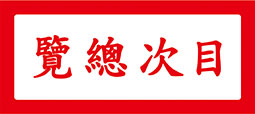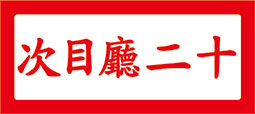The voyages to the Western Seas under the command of Admiral Cheng Ho (鄭和 1371-1433 ?) or Chen Ho , also known as Eunuch San-pao (三寶太監), is a hugely popular story. Yet few are familiar with the historical details. As early as 1954, the shipping magnate Mr. C. Y. Tung (董浩雲 1912-1982) envisioned a movie about Cheng Ho. He had hoped to launch the movie in 1955 to commemorate the 550th anniversary of Cheng Ho’s first voyage to the Western Seas. Nevertheless, actuality and want are frequently contradictory. After failing to raise any funds, and a succession of ineffectual efforts that lasted a few decades, the movie never materialized. However the enduring merits in the realm of literature engendered during pre-production are indeed worth lingering upon. In the 43rd year of the Republic (1954), the eminent tz’u poet Mr. Soong Hsün-leng (宋訓倫 1910-2010) wrote a piece of rhythmical prose titled Inception for the purpose of fundraising. In the 49th year of the Republic (1960), the distinguished playwright Mr. Yao K’o (姚克 1905-1991) wrote an outline of the screenplay. In the 56th year of the Republic (1967), the celebrated novelist Mr. Ma Pin (馬彬 1924-1983), also known as Nan Kung Po (南宮搏), wrote an abridgment of his screenplay. In the following year, he produced the first draft of the complete screenplay. Now that we commemorate the 590th death anniversary of the great explorer and navigator Cheng Ho, we will present the writings of these three literati in three separate issues, an exceptional literary event itself.
Curatorial and Editorial Department
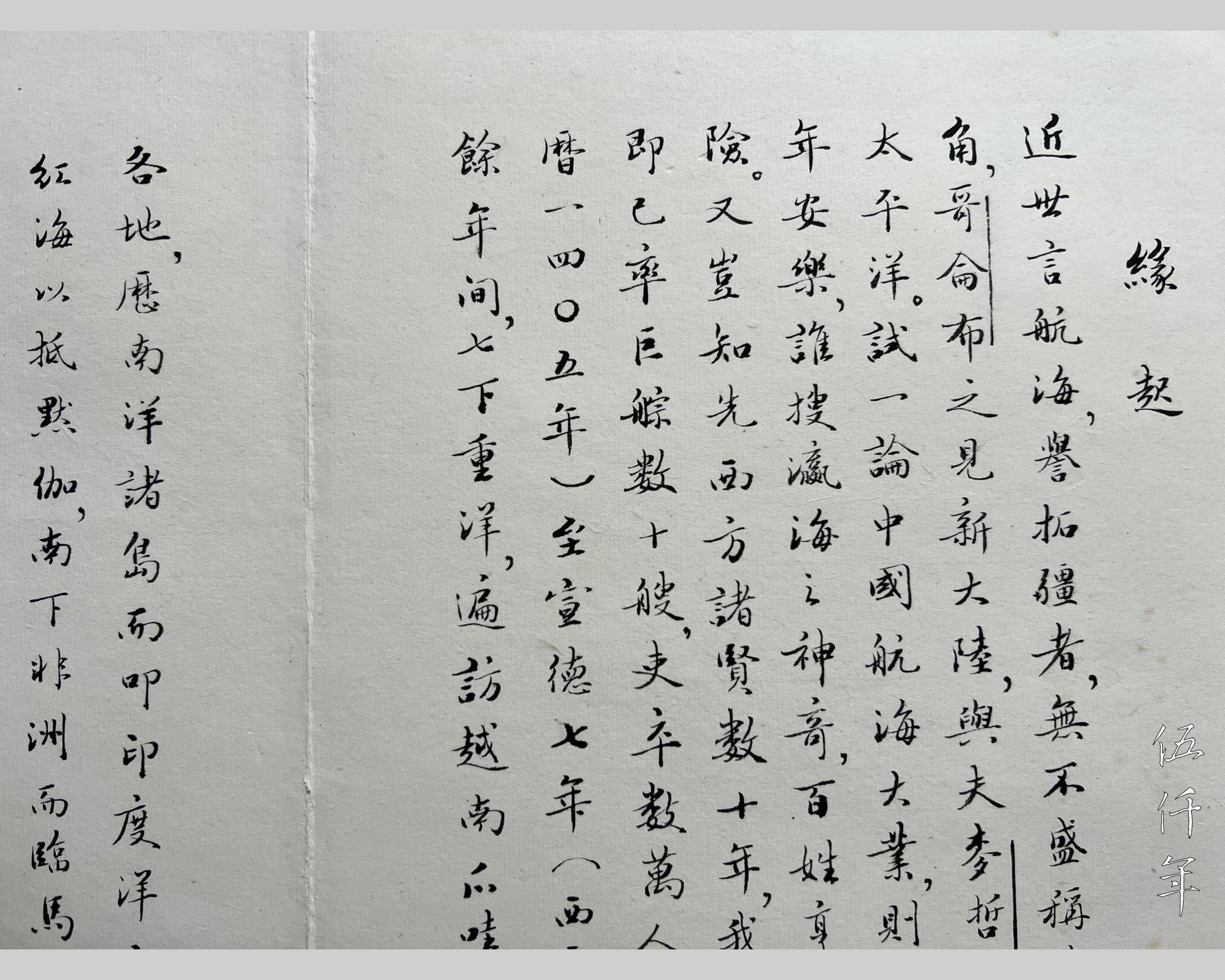
Detail of first page of Inception composed and handwritten by my late father Mr. Soong Hsün-leng
Six hundred and eighteen years ago, on 15 June in the 3rd year of the Yung-le reign (永樂) of the Ming dynasty, corresponding to 11 July 1405 of the Gregorian Calendar, Chen Ho (鄭和) commonly spelled as Cheng Ho, was appointed by imperial order to lead the first mission to the countries bordering South China Sea and Indian Ocean. Over the next twenty eight years, he undertook seven voyages, traveling as far as the mouth of Jubba River in Africa and T’ien-fang (天方) in the Arabian Peninsula of West Asia, now known as the holy city of Mecca in present-day Saudi Arabia. These expeditions spanned the reigns of three emperors: Emperor Ch’eng-tsu (成祖), Emperor Jen-tsung (仁宗), and Emperor Hsüan-tsung (宣宗). They are known to the world as the Voyages of Eunuch San-pao to the Western Seas (三寶太監下西洋) or (三保太監下西洋), and initiated an unprecedented chapter in Chinese navigation. The long bygone years since the inaugural voyage, the size of the fleet, and the sea distance covered were unmatched by Western explorers. To honour the 550th anniversary of Cheng Ho's first expedition, the government of the Republic of China designated 11 July as the Maritime Day of the Republic of China in the 44th year of the Republic (1955).
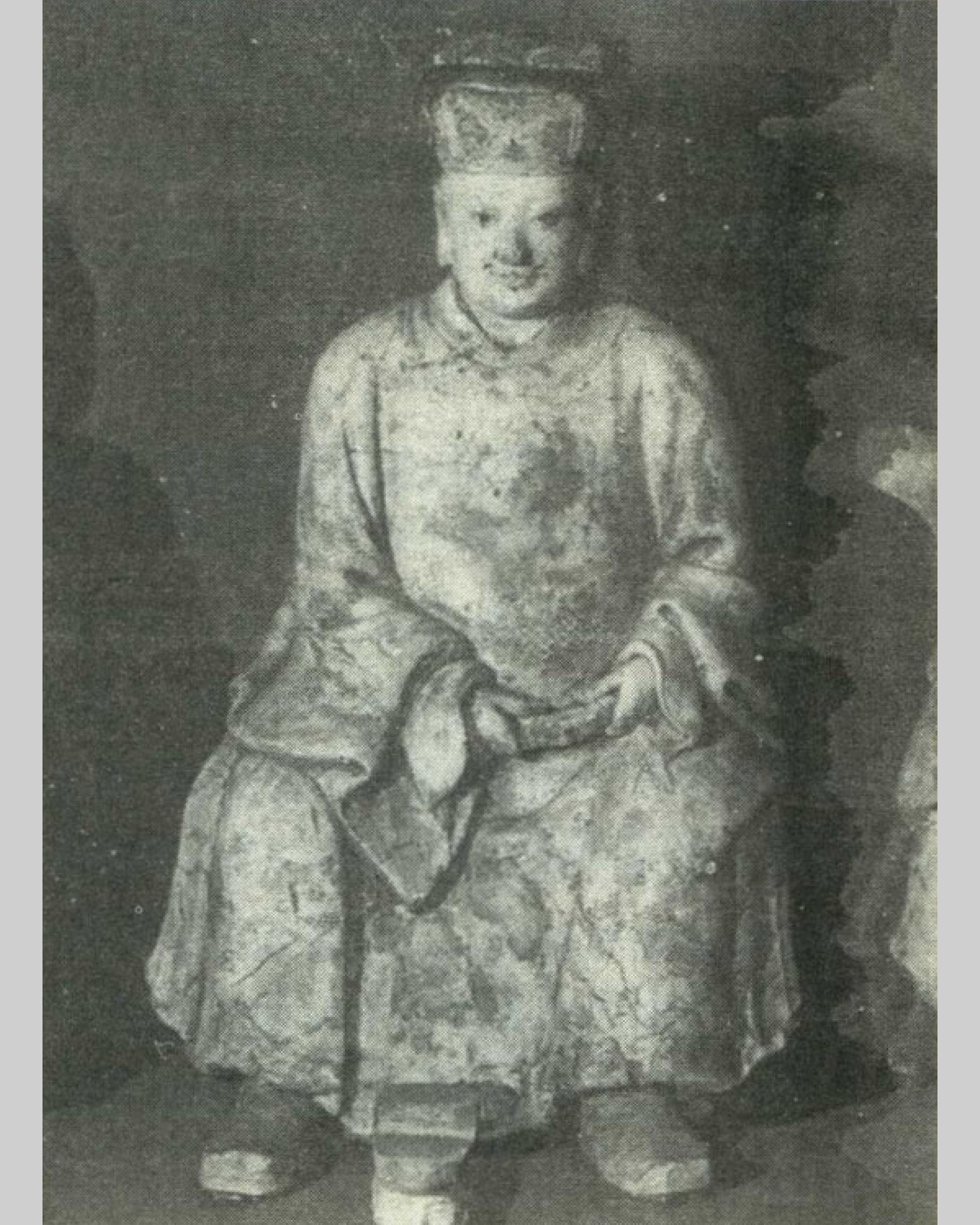
Clay figure of Admiral Cheng Ho excavated at Hsien-ying Palace in Yung-le City, Fukien Province
According to The History of Ming Dynasty, Volume 304, Chapter 192 on Eunuchs: The Biography of Cheng Ho, it says:
“Cheng Ho (鄭和) a native of Yunnan Province, was also known as eunuch San-pao (三寶 or 三保). He initially served Prince Yen (燕王) at his estate and demonstrated meritorious military skill during the insurrection, leading to various promotions as an eunuch. Emperor Ch’eng-tsu (成祖) suspected that Emperor Hui-tsung (惠宗) had fled overseas. He not only wished to track him down, but at the same time wanted to demonstrate Chinese military power abroad to showcase China’s wealth and strength. In June in the 3rd year of the Yung-le reign (1405), Cheng Ho and his colleagues, including Wang Ching-hung (王景弘), were ordered to undertake a mission as emissary to the Western Seas. The expedition consisted of more than 27,800 officers and soldiers and they brought a lot of gold coins to distribute overseas as rewards. Large ships were constructed, there were sixty-two ships that measured forty-four chang (丈) in length and eighteen chang (丈) in width. The fleet departed from Liu-chia River (劉家河) in Su-chou, arrived in Fukien, then set sail from Wu-hu Gate (五虎門), first reaching Champa (占城) in Vietnam, then voyaged onwards to many foreign countries. They proclaimed the decree of the Emperor and bestowed gifts upon the rulers. In cases where the locals did not submit, force was used to intimidate them.”
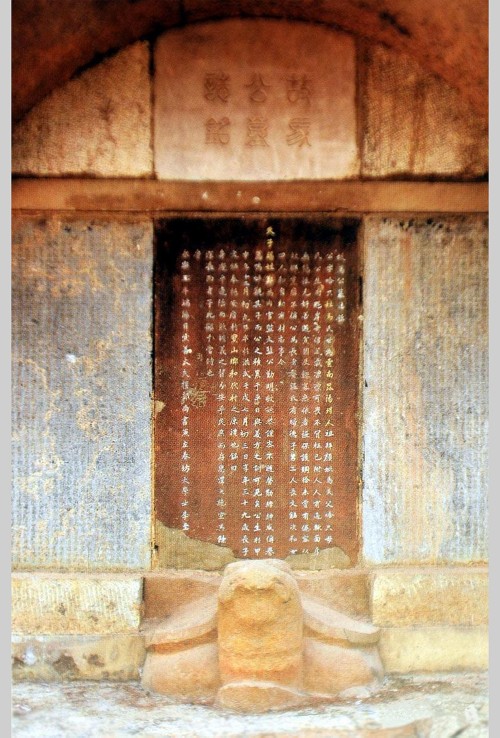
Epitaph of the Late Mr. Ma carved on stele in Chin-ning County, Yunnan Province
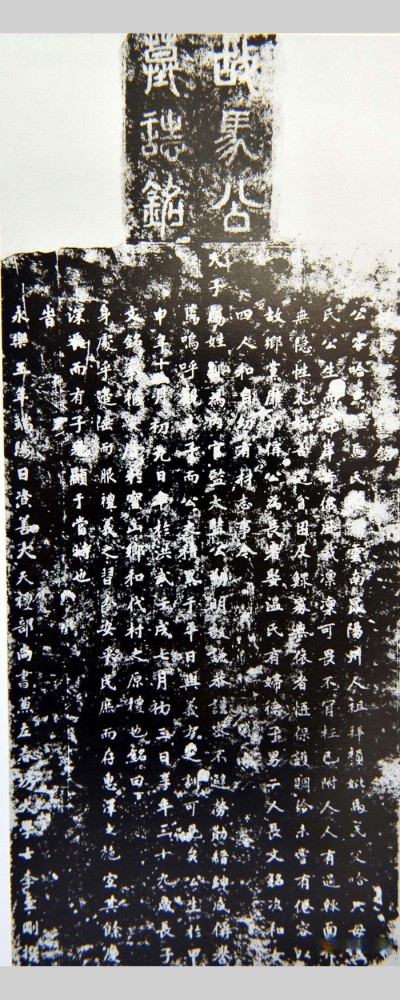
Ink rubbing of Epitaph of the Late Mr. Ma carved on stele
Cheng Ho was born in the 4th year of the Hung-wu reign (洪武1371). The exact year of his death is difficult to determine. Historians deduce that he passed away sometime between the 8th year (1433) and the 10th year (1435) of the Hsüan-te reign (宣德). If he did pass away in the 8th year of the Hsüan-te reign, it would be exactly 590 years ago this year. Epitaph of the Late Mr. Ma (故馬公墓誌銘), written by Li Chih-kan (李至剛), the Minister of Rites, and engraved on the tomb stele of Cheng Ho’s father in the 3rd year of the Yung-le reign (1405) provides much family information. Part of it reads:
“His name was Ha-chih (哈只), his surname was Ma (馬). For generations the Ma family lived in K’un-yang-chou (昆陽州) of Yunnan Province. His grandfather was Fei Yen (非顏), his grandmother’s maiden name was Ma. His father was Ha-chih (哈只), his mother’s maiden name was Wen (溫). …… He married a lady whose maiden name was also Wen, well-known for her virtuous qualities. They had two sons, the elder named Wen-ming (文銘), the younger named Ho (和), and there were four other daughters. Ho showed talent and ambition from a young age. He served the current Emperor, who granted him the surname Cheng (鄭) and appointed him as eunuch in the Directorate of Palace Eunuchs.”
This clarified that the original Han surname of Cheng Ho was Ma and he was a Muslim from Yunnan. The surname Cheng was bestowed on him by Emperor Yung-le.
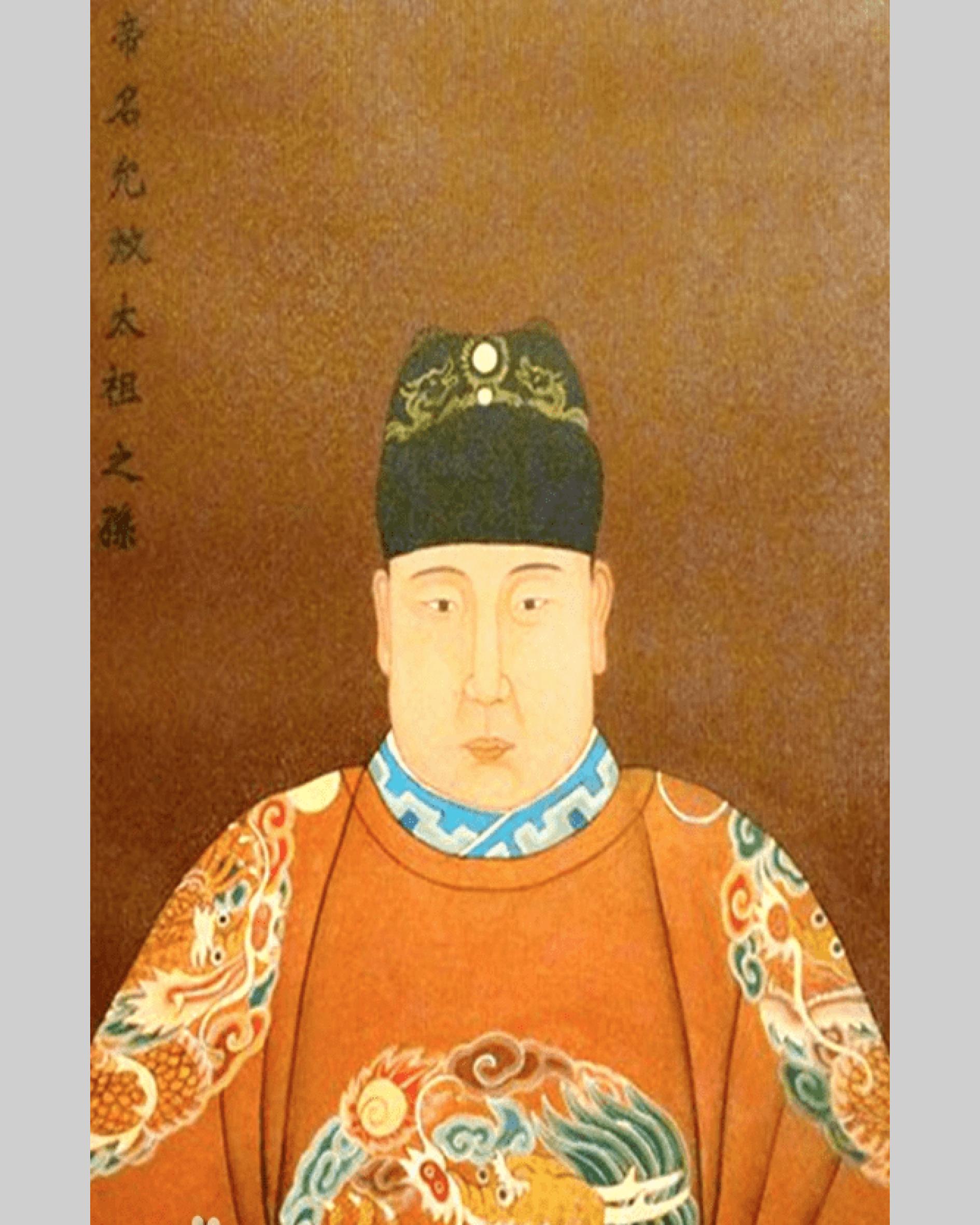
Portrait of Emperor Hui-tsung of the Ming dynasty
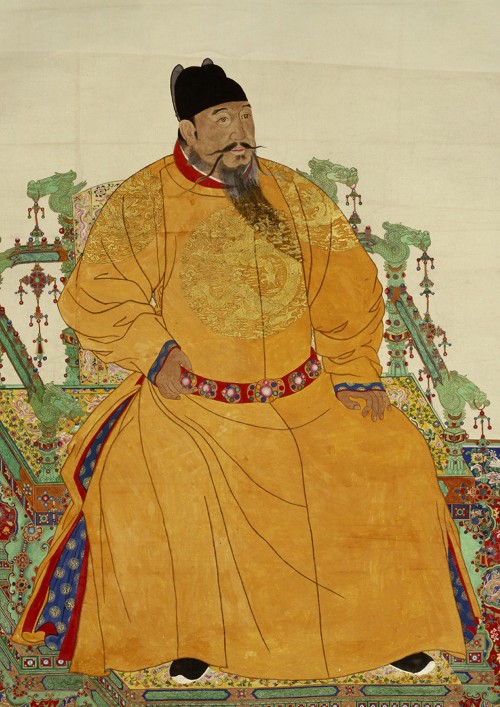
Portrait of Emperor Ch’eng-tsu of the Ming dynasty
The History of Ming Dynasty records that Cheng Ho “initially served Prince Yen”. Prince Yen was the 4th son of the Ming dynasty founder T’ai-tsu (太祖) Chu Yüan-chang (朱元璋). The name of Prince Yen was Chu Ti (朱棣 1360-1424). In the 31st year of the Hung-wu (洪武) reign (1398), T’ai-tsu passed away. The following year, in the 1st year of the Chien-wen (建文) reign (1399), Emperor Hui-tsung (惠宗) whose original name was Chu Yün-wen (朱允炆), ascended the throne and intended to reduce the power of the vassal princes. In response, Prince Yen launched an uprising and rebelled. In the 4th year of the Chien-wen reign (1402), Prince Yen captured the capital Nanking, changed the reign title to Yung-le (永樂), and was posthumously known as Emperor Ch’eng-tsu (成祖). This event is known in history as the Ching-nan Rebellion (靖難之變). The fate of Emperor Chien-wen remained hazy. His old ministers like Fang Hsiao-ju (方孝孺 1357-1402) refused to surrender and even wrote the four words “Yen Thief Usurped the Throne” (燕賊篡位), which eventually led to his execution along with all the relatives on his father’s side, his mother’s side, his wife’s side and his students’ side, a practice of intimidation known as the Slaughter of the Ten Family Branches. This elucidates the terror weaponized by tyrants and why they must be completely eradicated. The History of Ming Dynasty also mentions that “Emperor Ch’eng-tsu (成祖) suspected that Emperor Hui-tzong (惠宗) had fled overseas and wished to track him down”, thus Cheng Ho’s voyages to the Western Seas also carried the secret order to exterminate all surviving loyalists to the last emperor as well as the last emperor should he be encountered overseas.
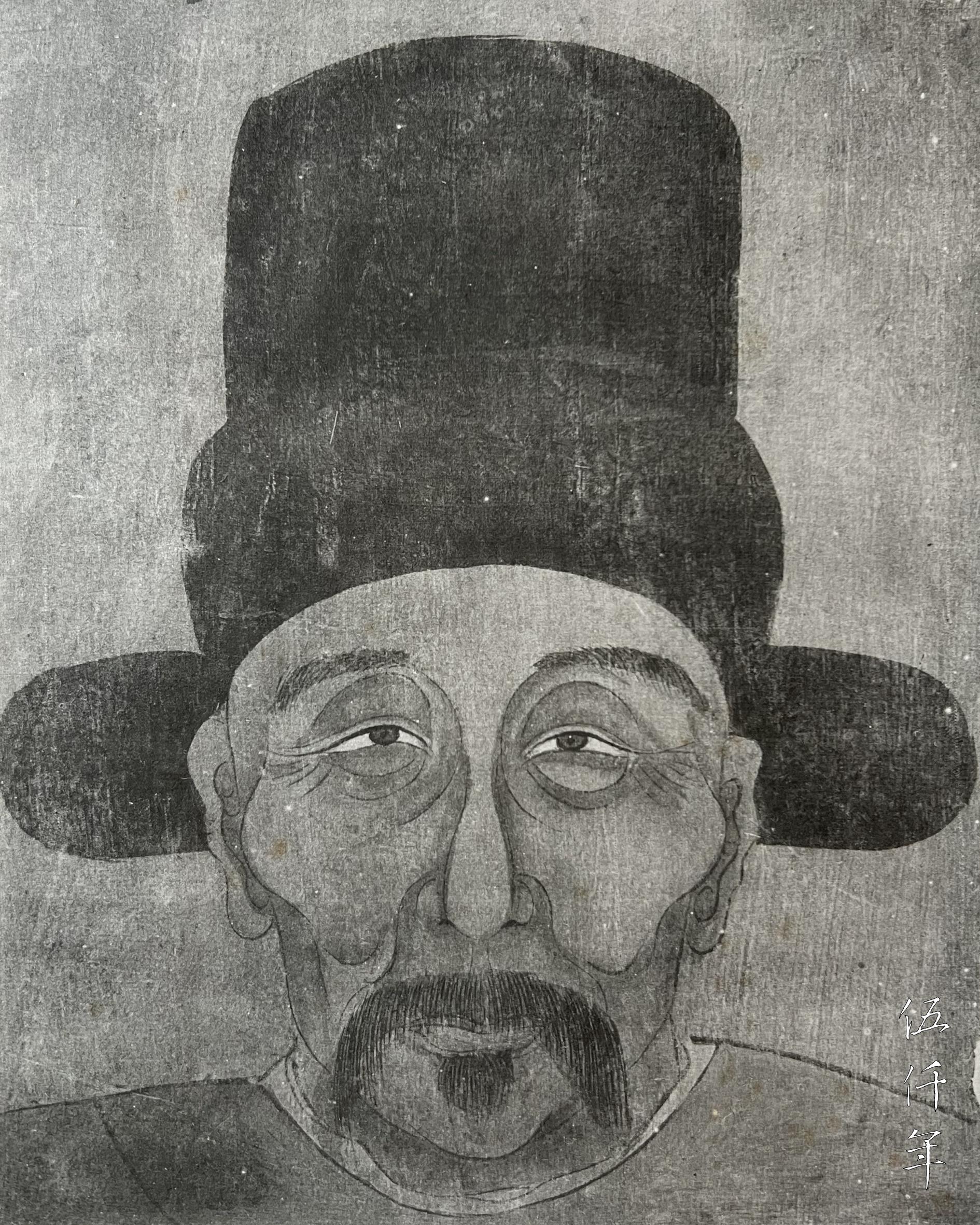
Portrait of Fang Hsiao-ju
Cheng Ho’s demeanor and talent were also recorded in other historical texts. The Unofficial History of Ming Dynasty (明外史記) describes Cheng Ho as “intelligent, knowledgeable in strategy and warfare, and experienced in battles”. The Book of Ming Dynasty (明書) mentions that he had a “stout and imposing physique, eloquent and astute”. The Ming dynasty scholar-official and fortune-teller Yuan Chung-che (袁忠徹) was particularly graphic in describing Cheng Ho’s appearance in his work Ku-chin Shih-chien (古今識鑒). The text says:
“The eunuch Cheng Ho is also known as San-pao. A native of Yunnan Province, he stood nine feet tall, with a trunk-like waist. His forehead, cheeks and jaw were pronounced, his nose was small. Those with such facial characteristics would attain high positions in life. His ears were white, extending beyond his face, his teeth were neat like a string of shells. His gait resembled that of a tiger, and his voice was sonorous. He gained recognition for his achievements in the Ching-nan Rebellion and was appointed as eunuch in the Directorate of Palace Eunuchs. When Emperor Yung-le wished to reach out to the foreigners in East and South, he sought advice about entrusting troops to San-pao. I replied, ‘The appearance, talent, and intellect of San-pao surpass all other eunuchs. Observing his aura and countenance, I believe he is indeed suitable for the task.’ Thus, he was entrusted to proceed and wherever he went, he was feared and respected.”
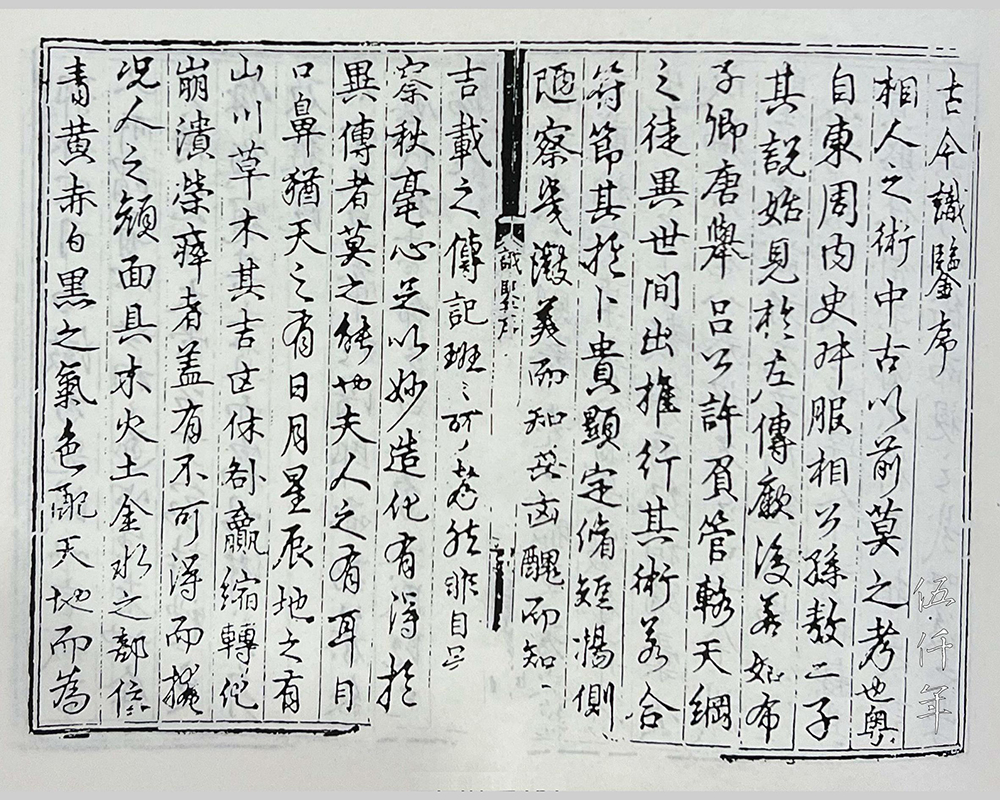
Introduction of Ku-chin Shih-chien (古今識鑒)
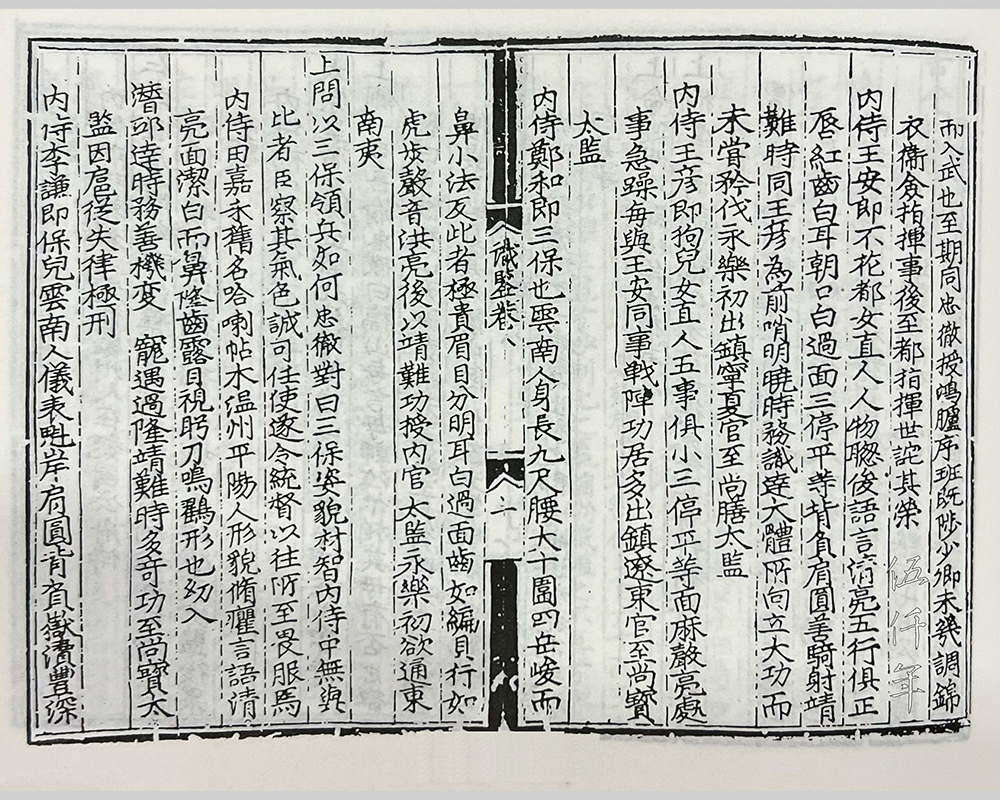
Inside page of Ku-chin Shih-chien (古今識鑒)
Cheng Ho was indeed a military talent, distinguishing himself in helping Prince Yen usurp the throne. In January of the 2nd year of the Yung-le reign (1404), he was selected as eunuch in the Directorate of Palace Eunuchs. In the following year, he was promoted as envoy of important missions to foreign lands.
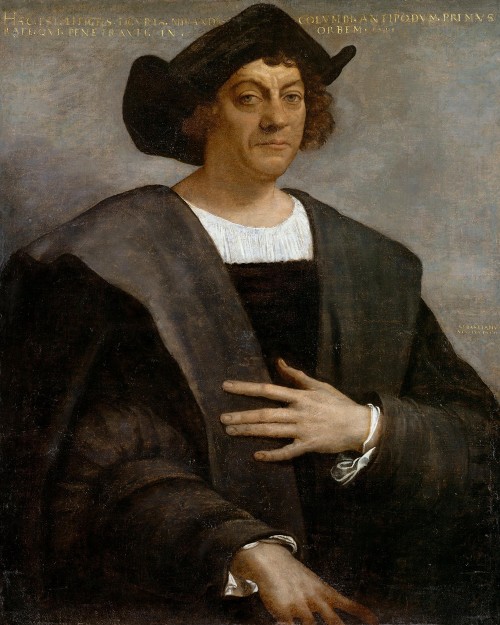
Portrait of the Italian navigator Christopher Columbus
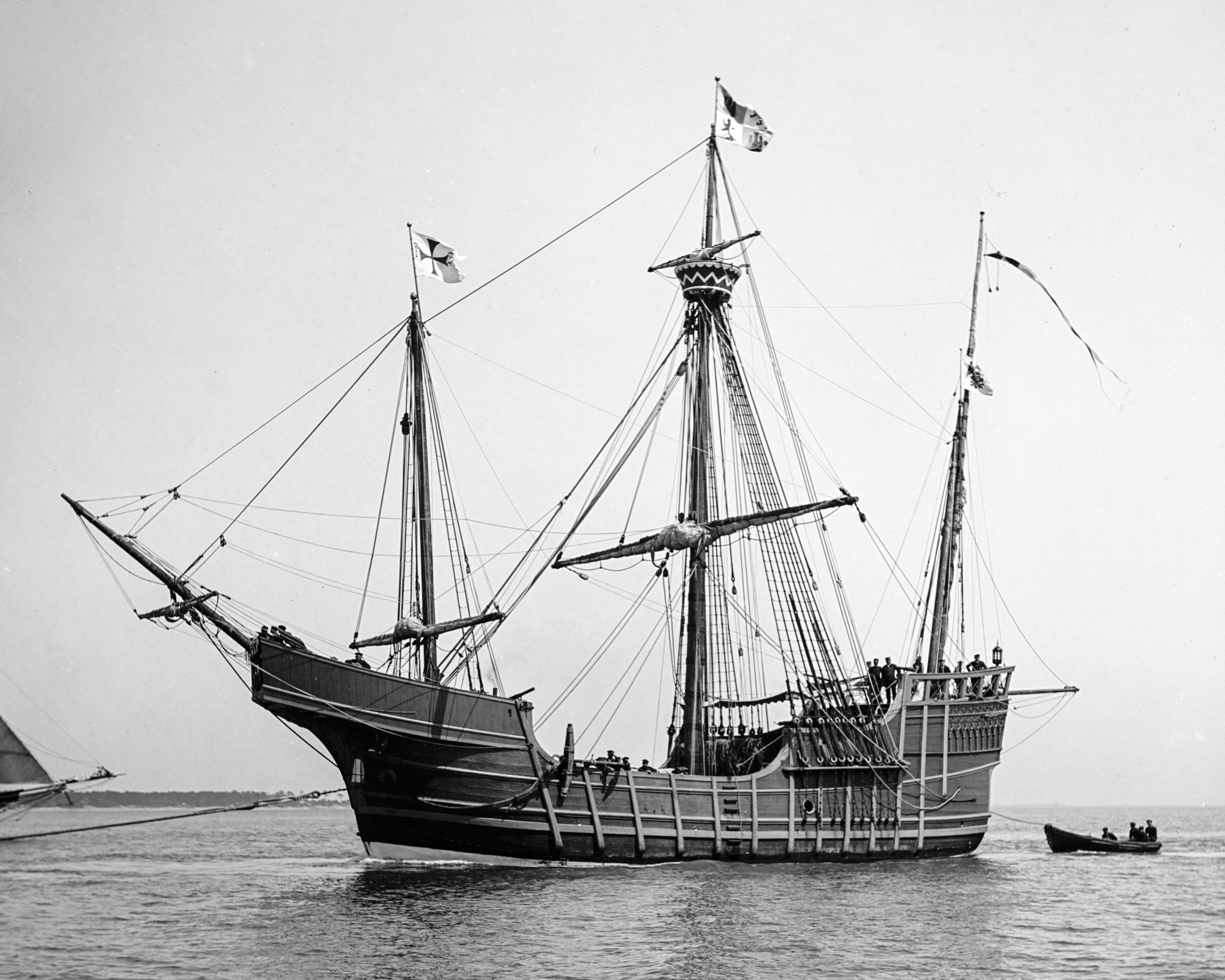
A reproduction of the Santa Maria
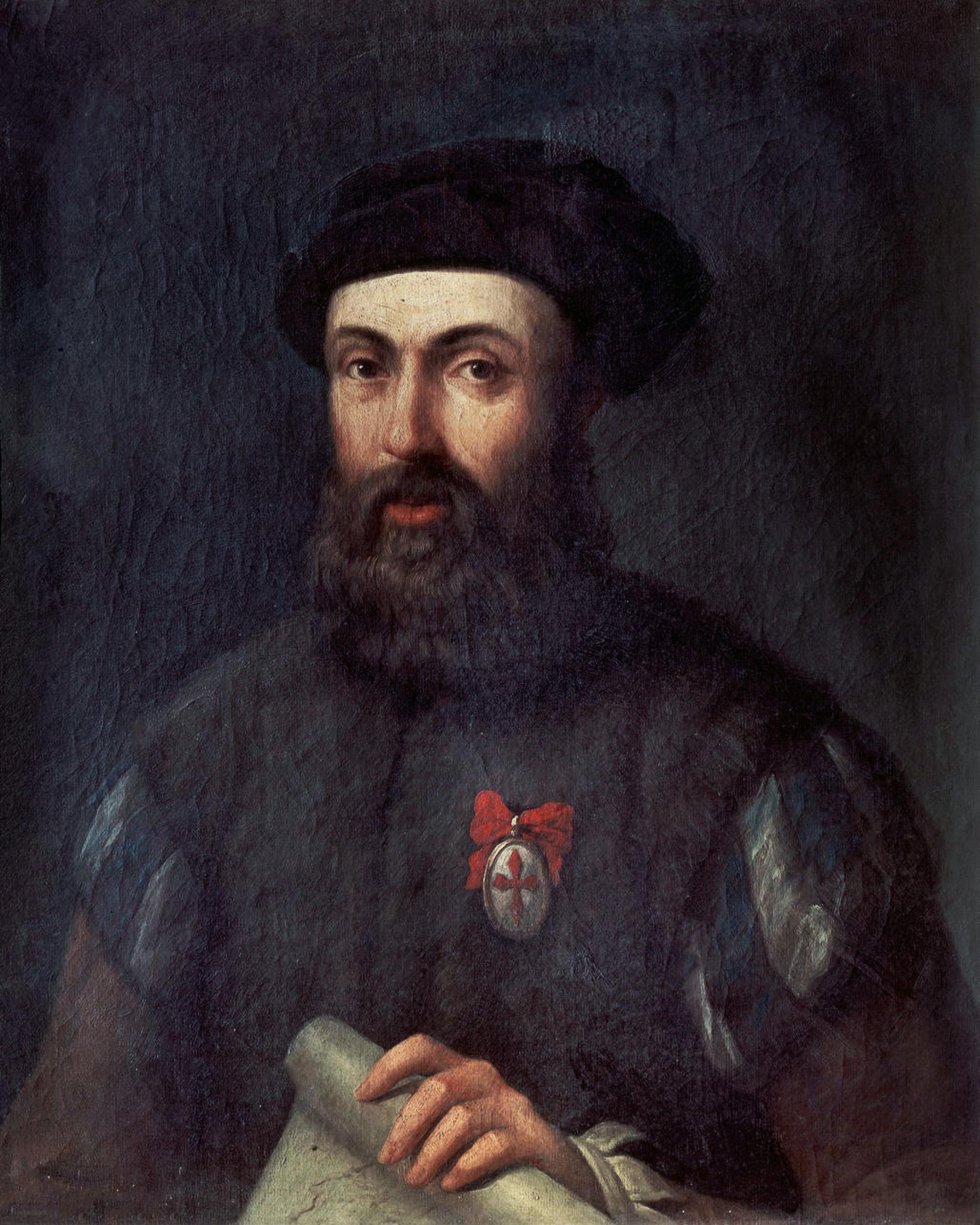
Portrait of the former Portuguese navigator Ferdinand Magellan
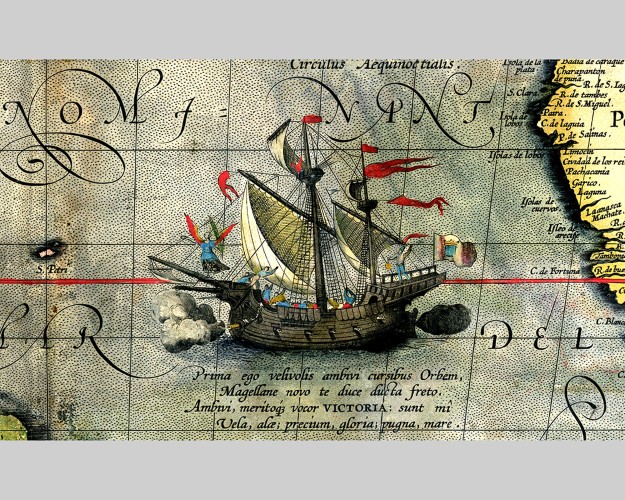
An illustration of the Victoria
According to The History of Ming Dynasty, Cheng Ho’s fleet consisted of sixty two larger vessels known as Pao Ship or Treasure Ship, each forty-four chang (丈) in length and eighteen chang (丈) in width, enlisting nearly 27,800 officers and soldiers. If we use excavated ruler from Ming archaeological site as reference, one chang is equal to 2.83 meters. Hence a Pao ship would be about 124.52 meters long and 50.94 meters wide. Eighty-seven years after the 3rd year of the Yung-le reign (1405), which is 1492, the Italian navigator Christopher Columbus led three ships across the Atlantic Ocean, reaching the islands of the West Indies in the Americas. He had about 90 crew members, and the largest ship, the Santa Maria, was 19 meters long and 5.5 meters wide. One hundred and fourteen years after the 3rd year of the Yung-le reign (1405), which is 1519, the former Portuguese navigator Ferdinand Magellan led five ships and discovered a passage connecting Chile in South America with the Atlantic and Pacific Oceans, later named the Strait of Magellan. The fleet had about 234 crew members, and their most famous ship, the Victoria, was approximately 18 to 21 meters long. The great maritime expeditions of the West took place nearly a hundred years after the Chinese expeditions, however, in terms of ship size, number of vessels and crew members, they were worlds apart in comparison with Cheng Ho’s fleet.
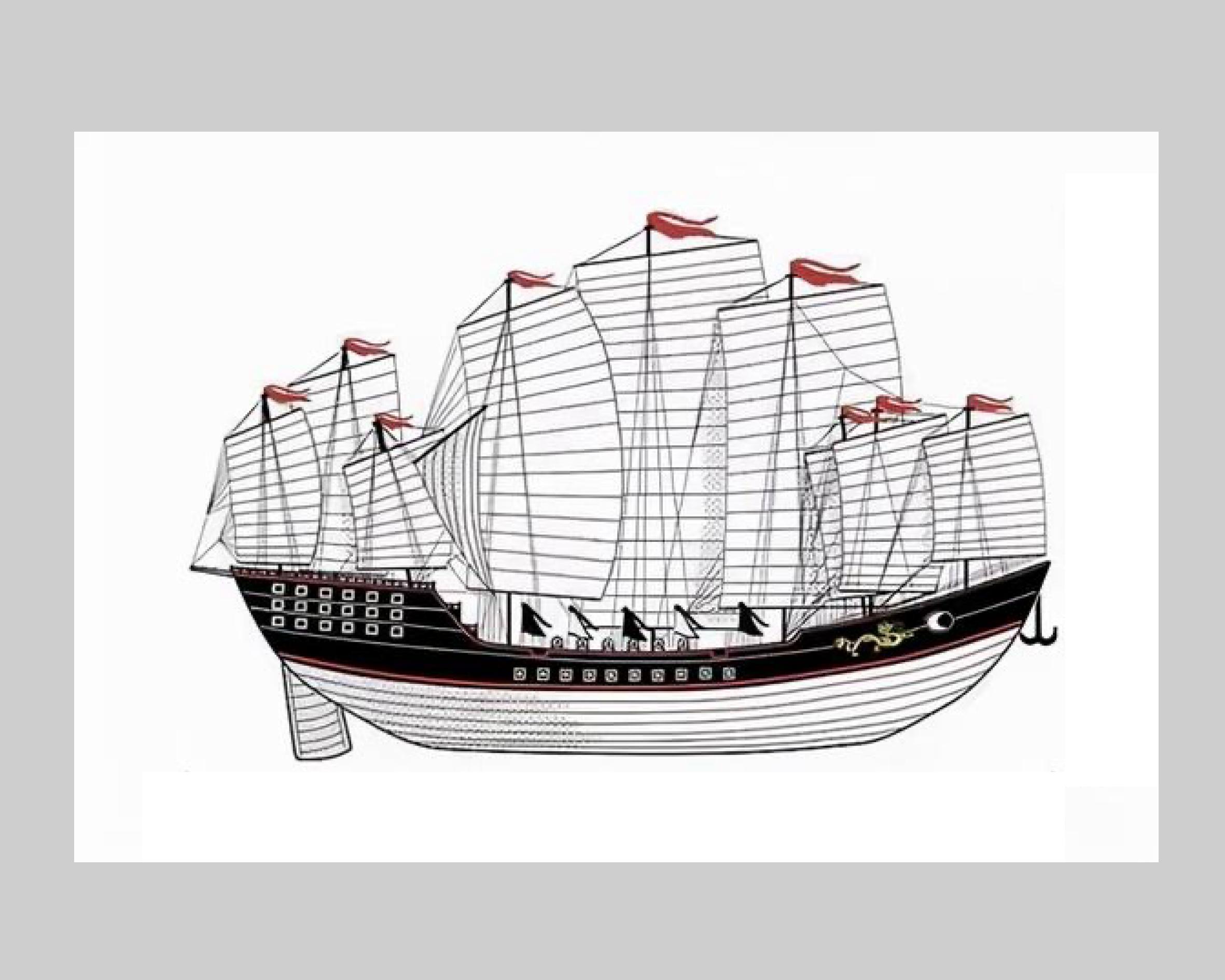
Illustration of Cheng Ho’s Pao Ship or Treasure Ship
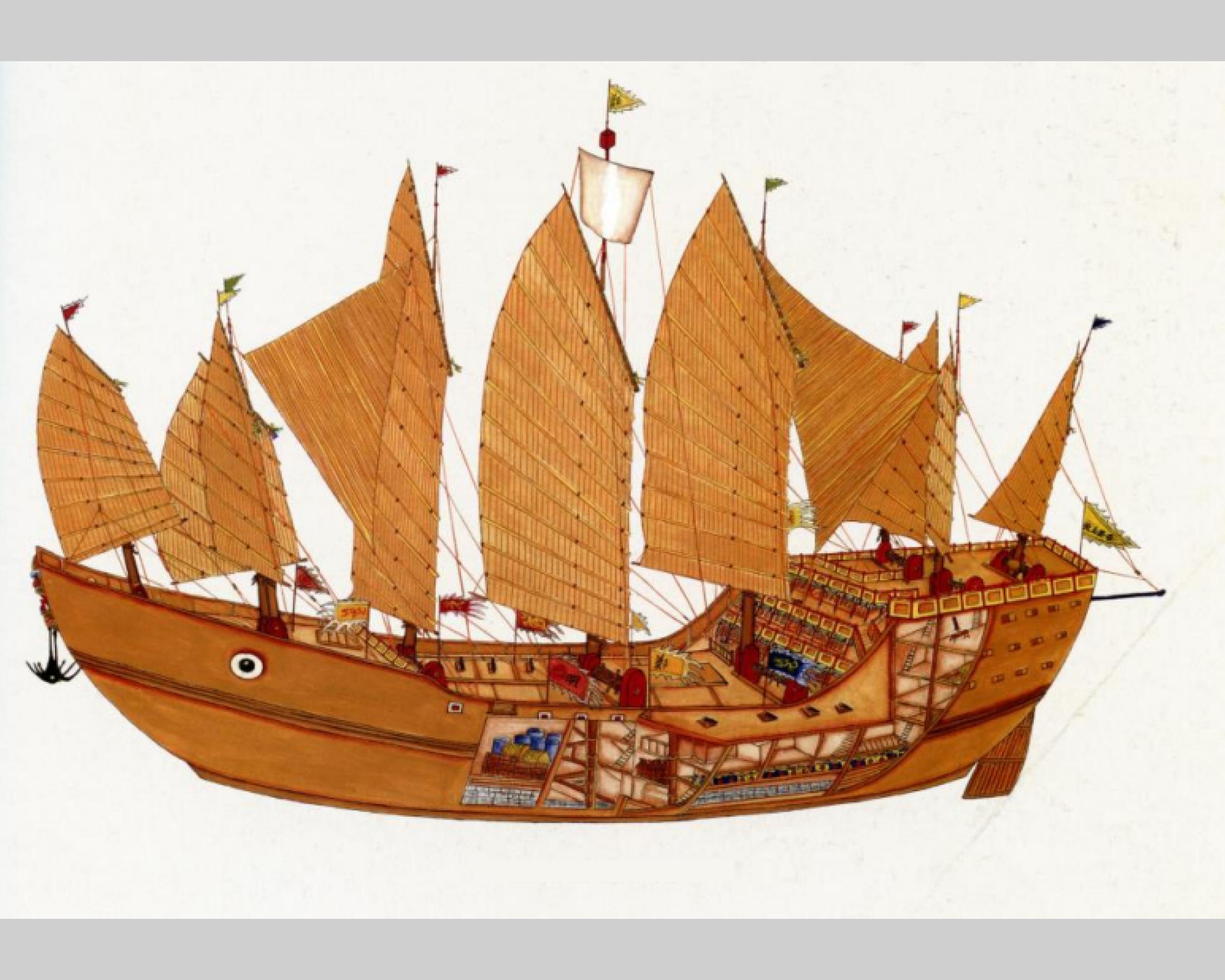
Illustration of Cheng Ho’s Pao Ship or Treasure Ship
Altogether Cheng Ho sailed seven times to the Western Seas. The departure dates and the routes are as follows:
For the First Voyage, the fleet departed in the winter of the 3rd year of the Yung-le reign (1405). They reached Champa in Vietnam; Siam; Java and Palembang in Indonesia; Malacca in Malaysia; Ceylon; Kozhikode in India.
For the Second Voyage, the fleet departed in the winter of the 5th year of the Yung-le reign (1407). They reached Champa in Vietnam; Siam; Kalimantan; Java in Indonesia; Malacca in Malaysia; Ceylon; Kochi and Kozhikode in India.
For the Third Voyage, the fleet departed in December of the 7th year of the Yung-le reign, which corresponds to January 1410. They reached Champa in Vietnam; Siam; Java in Indonesia; The Maldives; Kollam, Kochi and Kozhikode in India.
For the Fourth Voyage, the fleet departed in the winter of the 11th year of the Yung-le reign (1413). They reached Champa in Vietnam; Java in Indonesia; Kelantan, Pahang, and Malacca in Malaysia; Ceylon; The Maldives; Kochi and Kozhikode in India; Mogadishu in Somalia; Hormuz in Iran; and Kilwa Kisiwani in Tanzania.
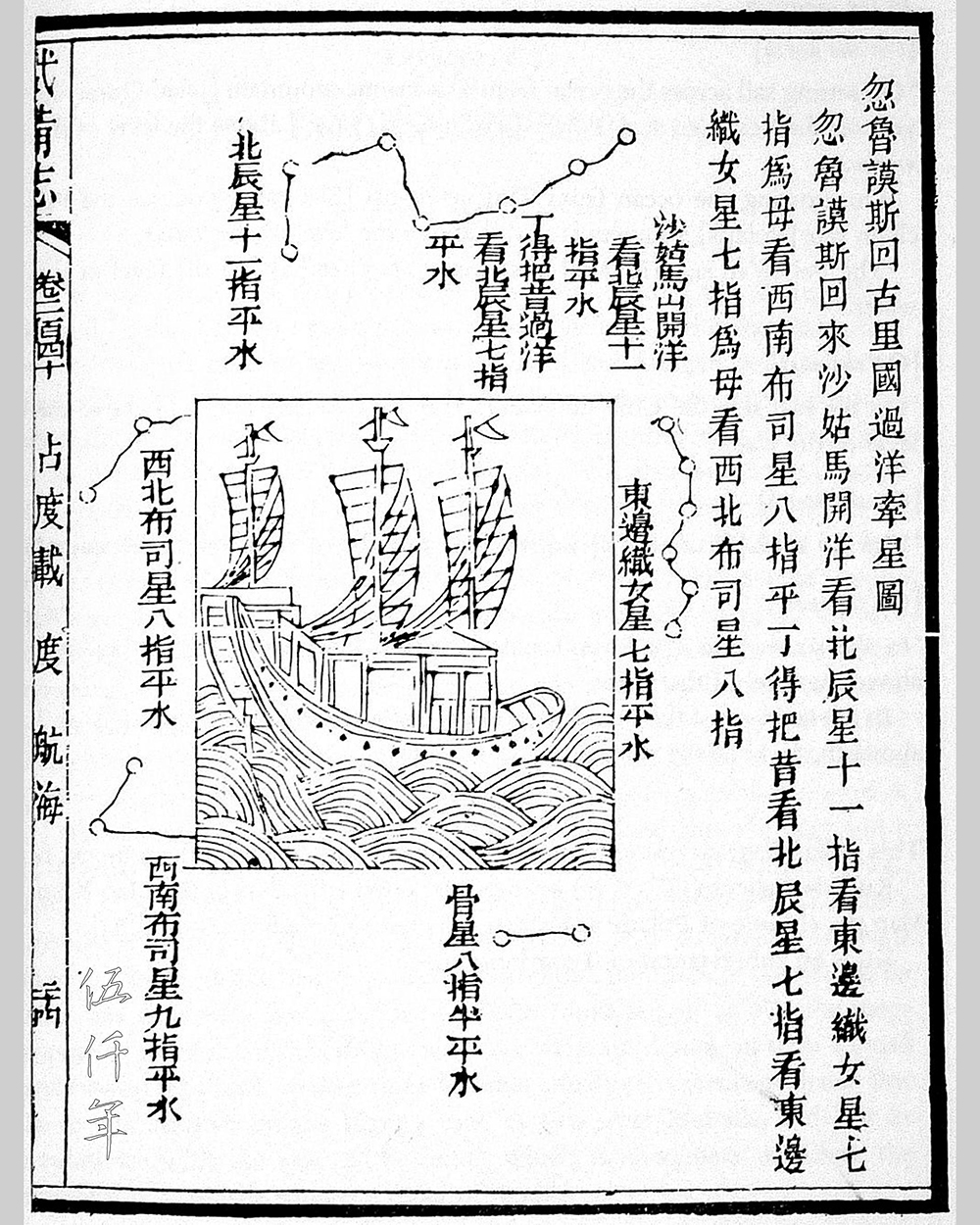
An illustration of Cheng Ho’s vessel with three masts and three sails in Wu-pei-chih (武備誌) by Mao Yüan-i (茅元儀)
For the Fifth Voyage, they departed in the winter of the 15th year of the Yung-le reign (1417). They reached Champa in Vietnam; Java in Indonesia; Pahang and Malacca in Malaysia; Ceylon; Kochi and Kozhikode in India; The Maldives; Mogadishu and Barawa in Somalia; Aden in Yemen; Mukalla in the southern coast of the Arabian Peninsula; Hormuz in Iran; and Kilwa Kisiwani in Tanzania.
For the Sixth Voyage, the fleet departed in the 19th year of the Yung-le reign (1421). They reached Champa in Vietnam; Siam; Malacca in Malaysia; Bengal in India; Ceylon; Kochi and Kozhikode in India; Dhofar in Oman; Aden in Yemen; Mukalla in the southern coast of the Arabian Peninsula; Mogadishu and Barawa in Somalia; Hormuz in Iran.
For the Seventh Voyage, the fleet departed on 9 December in the 6th year of the Hsüan-tsung reign, which corresponds to 12 January 1432. They reached Champa in Vietnam; Siam; Java, Palembang and Sumatra in Indonesia; Malacca in Malaysia; Ceylon; Kollam, Kochi and Kozhikode in India; The Maldives; Hormuz in Iran; Dhofar in Oman; Aden in Yemen; Mukalla on the southern coast of the Arabian Peninsula; Mecca in Saudi Arabia; Mogadishu, Barawa and Kismayo in Somalia.
Cheng Ho’s first three voyages went as far as India, the fourth voyage reached Iran in the Middle East, Somalia and Tanzania in Africa. The fifth voyage reached Yemen in the Middle East, Somalia and Tanzania in Africa. The sixth voyage reached Oman and Yemen in the Middle East, Somalia in Africa. The seventh voyage reached Oman and Saudi Arabia in the Middle East, and Somalia in Africa.
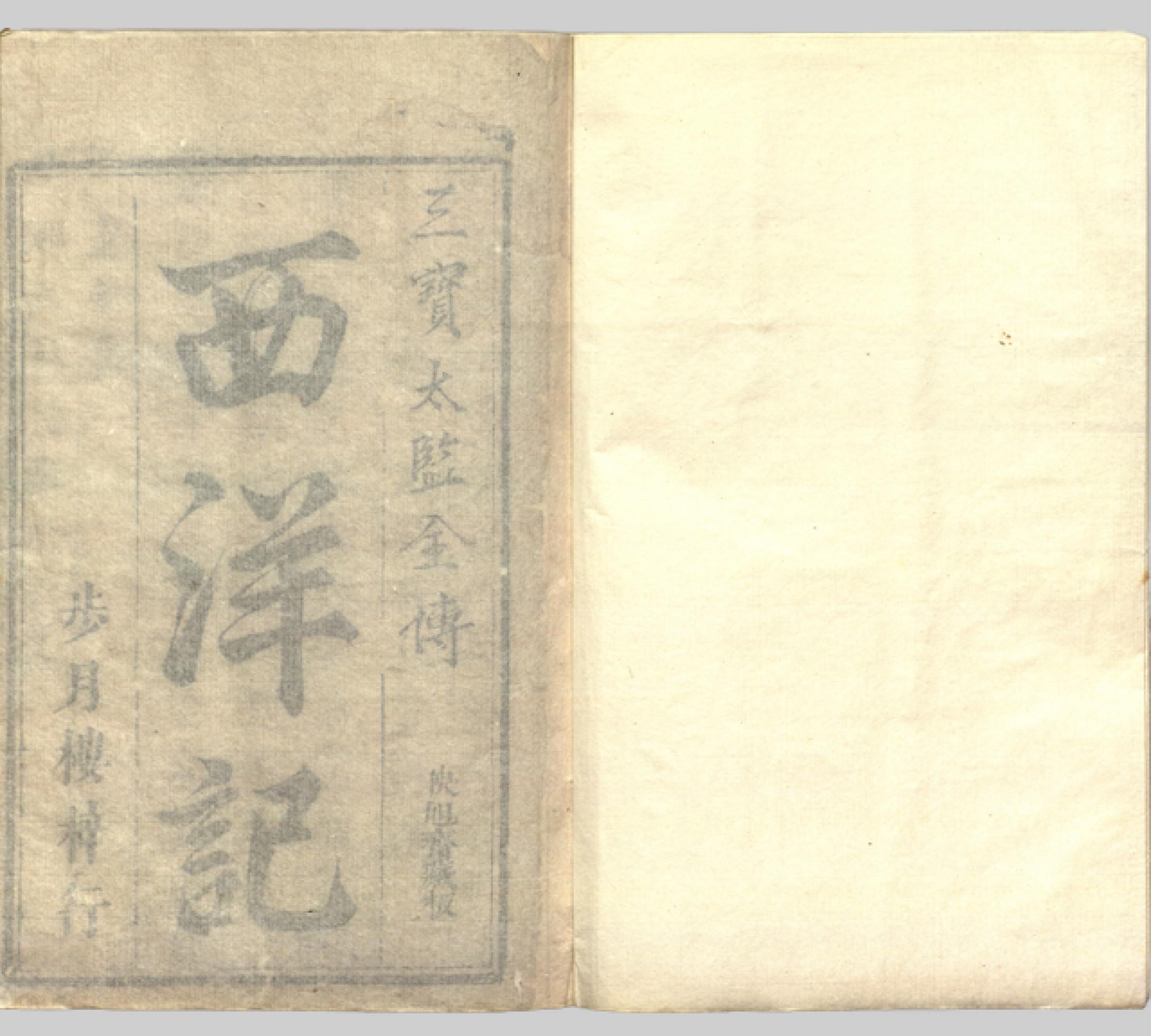
Title page of Chronicle of Eunuch San-pao’s Voyages to the Western Seas by Lo Mao-teng
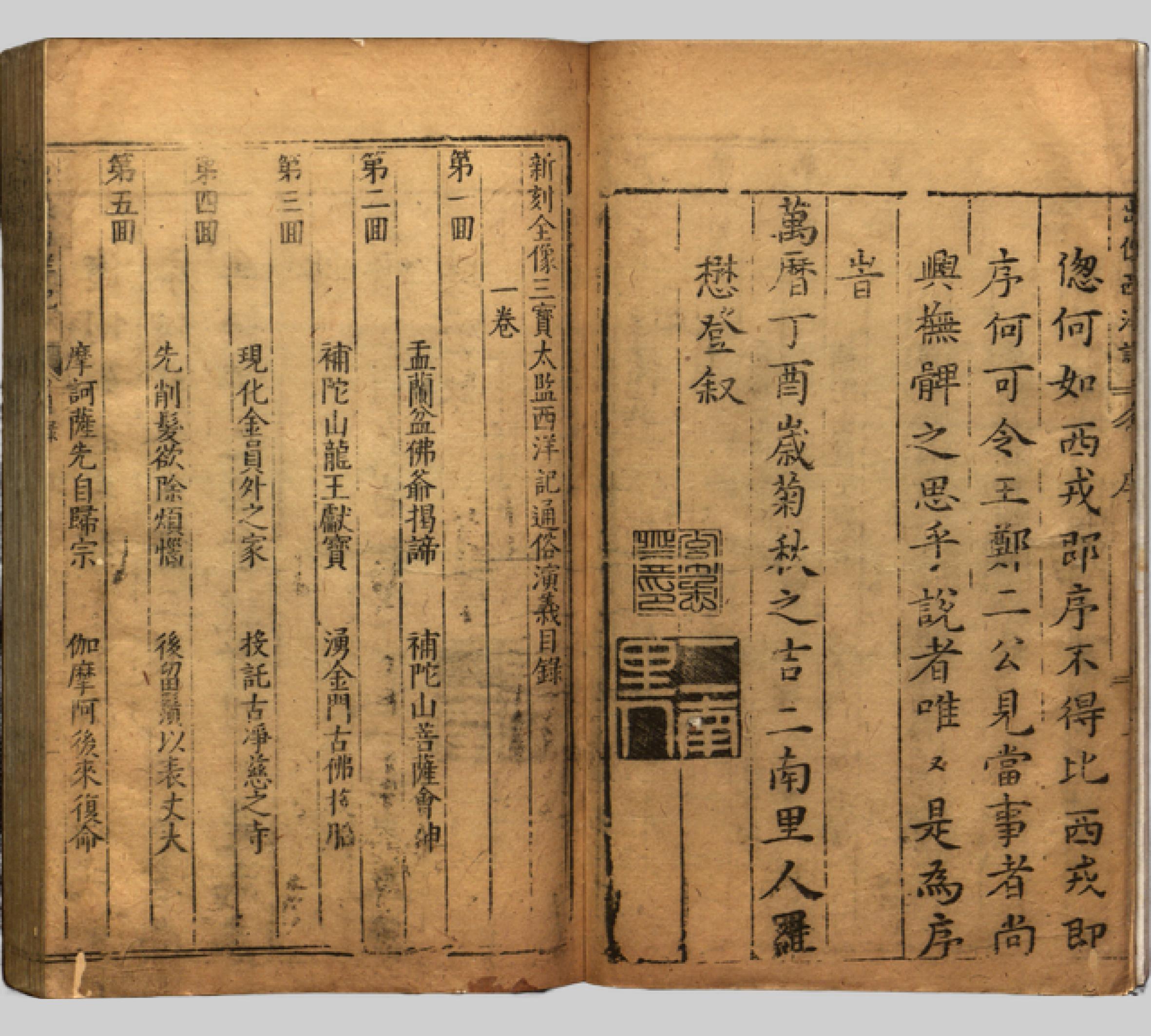
Inside page of Chronicle of Eunuch San-pro’s Voyages to the Western Seas by Lo Mao-teng
Cheng Ho’s exploits have long been adapted into novels and dramas. In the 25th year of the Wan-li reign (萬曆 1597), Lo Mao-teng (羅懋登) wrote San-pao T’ai-chien Hsi-yang Chi (Chronicle of Eunuch San-pao’s Voyages to the Western Seas 三寶太監西洋記), also known as San-pao T’ai-chien Hsi-yang Chi T'ung-su Yen-i (The Popular Fiction of Eunuch San-pao’s Voyages to the Western Seas 三寶太監西洋記通俗演義). In late Ch'ing, Peng Ho-ling (彭鶴齡) wrote San-pao T’ai-chien Hsia-hsi-yang (San-pao’s Voyages to the Western Seas 三保太監下西洋). As for dramas, in late Ming during the Wan-li reign, there was Feng-t’ien-ming San-pao Hsia-hsi-yang (San-pao’s Voyages by Imperial Decree to the Western Seas 奉天命三保下西洋) written by an anonymous author.
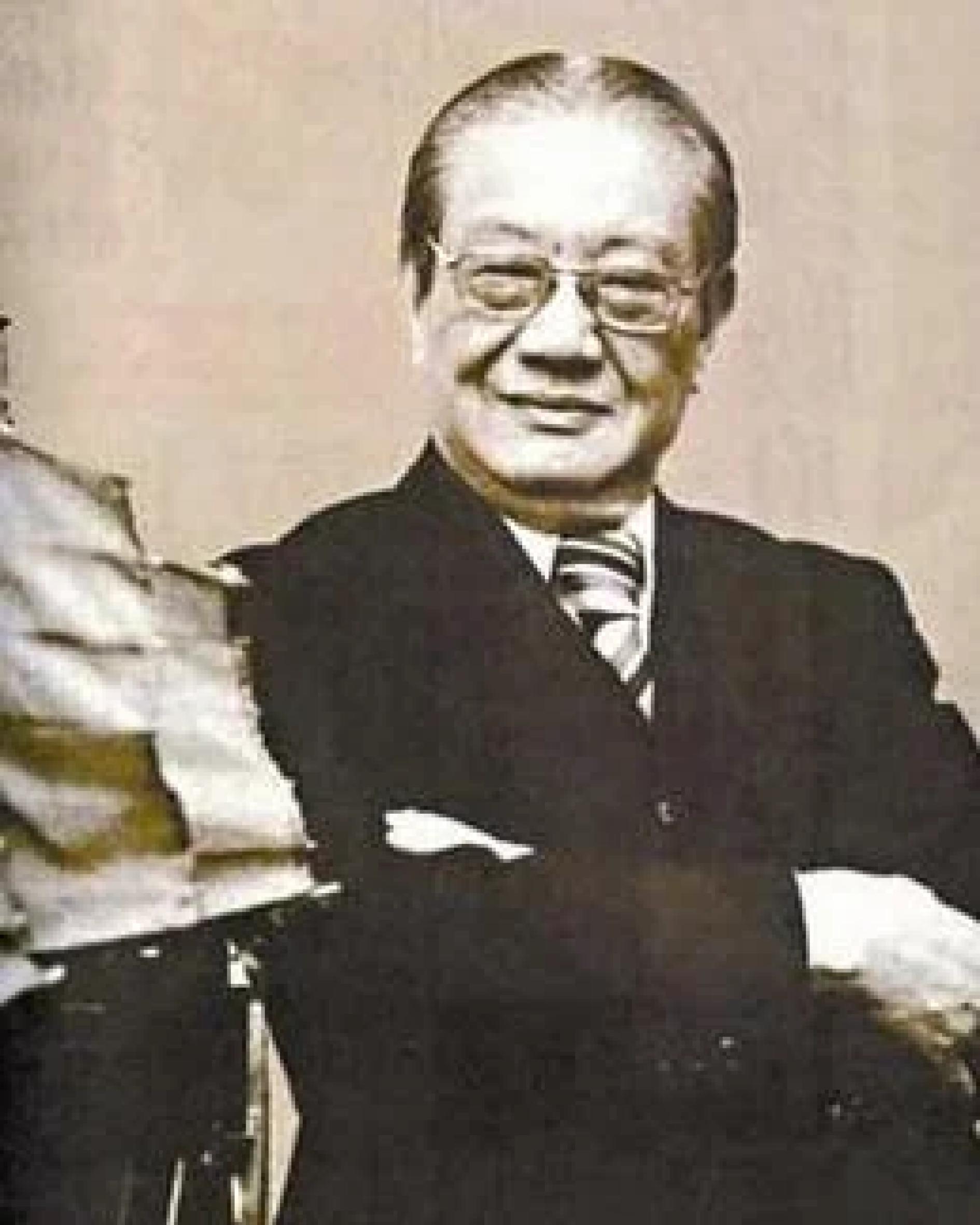
Portrait of Uncle C. Y. Tung
In the last century, with the flourishing of the film industry, the Hong Kong shipping magnate Uncle C. Y. Tung (Chao-yung Tung 董浩雲) propositioned to raise funds to make a movie about the story of eunuch San-pao Cheng Ho in the 43rd year of the Republic (1954). Although fund raising was unsuccessful and came to nothing, his enthusiasm towards this project did not wane for decades. He continued to promote the film concept on a great number of occasions, he engaged well known scriptwriters such as Uncle Yao K’o (姚克) the dramatist, and Uncle Ma Pin (馬彬) the novelist, also known as Nan Kung Po (南宮搏), to write the screenplays for the eunuch San-pao movie. The writings left behind by Yao K’o and Nan Kung Po follow the Ming and Ch’ing tradition of novels and dramas about Cheng Ho, and they should be rightfully appreciated in this context.
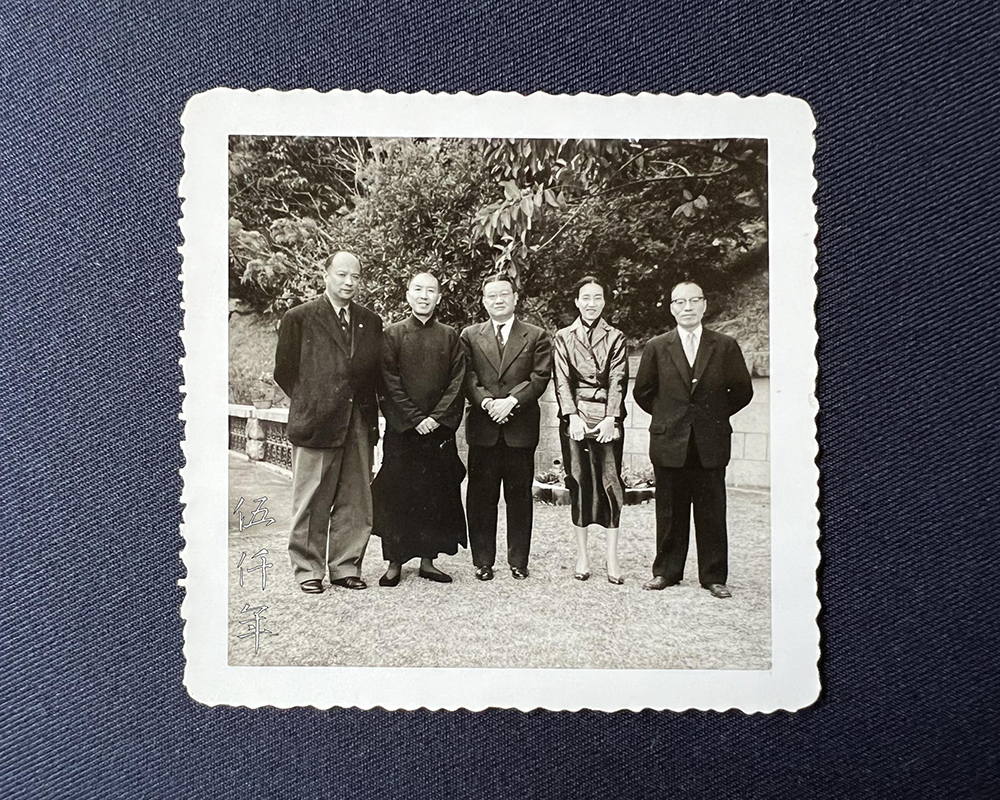
Group portrait of my late father Mr. Soong Hsün-leng (1st right), Aunt Yao K’o (2nd right), Uncle C. Y. Tung (centre), Uncle Yao K’o (2nd left), Uncle Kao Ling-mei (1st left)
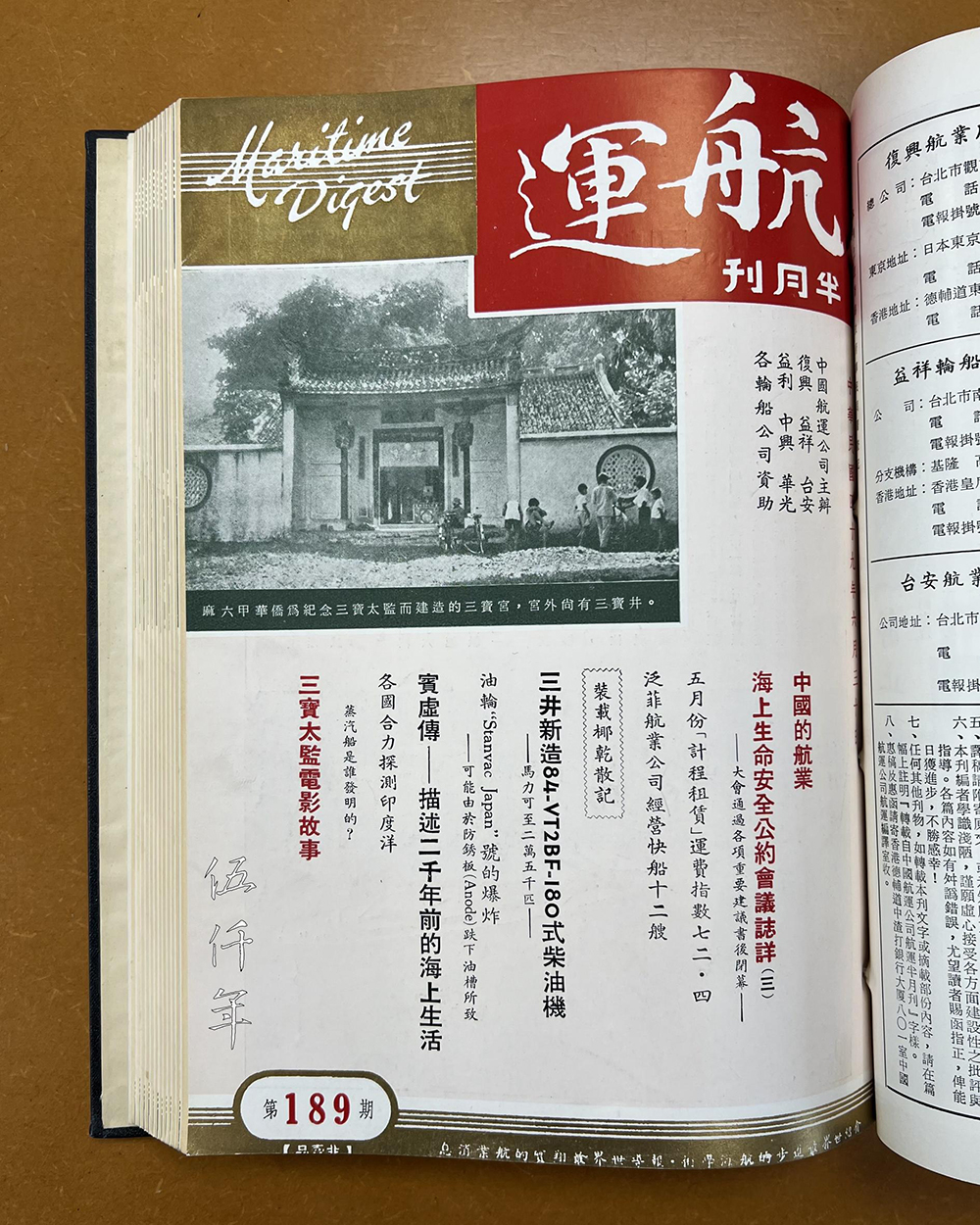
Front cover of Maritime Digest, Issue Number 189 dated 49th year of the Republic
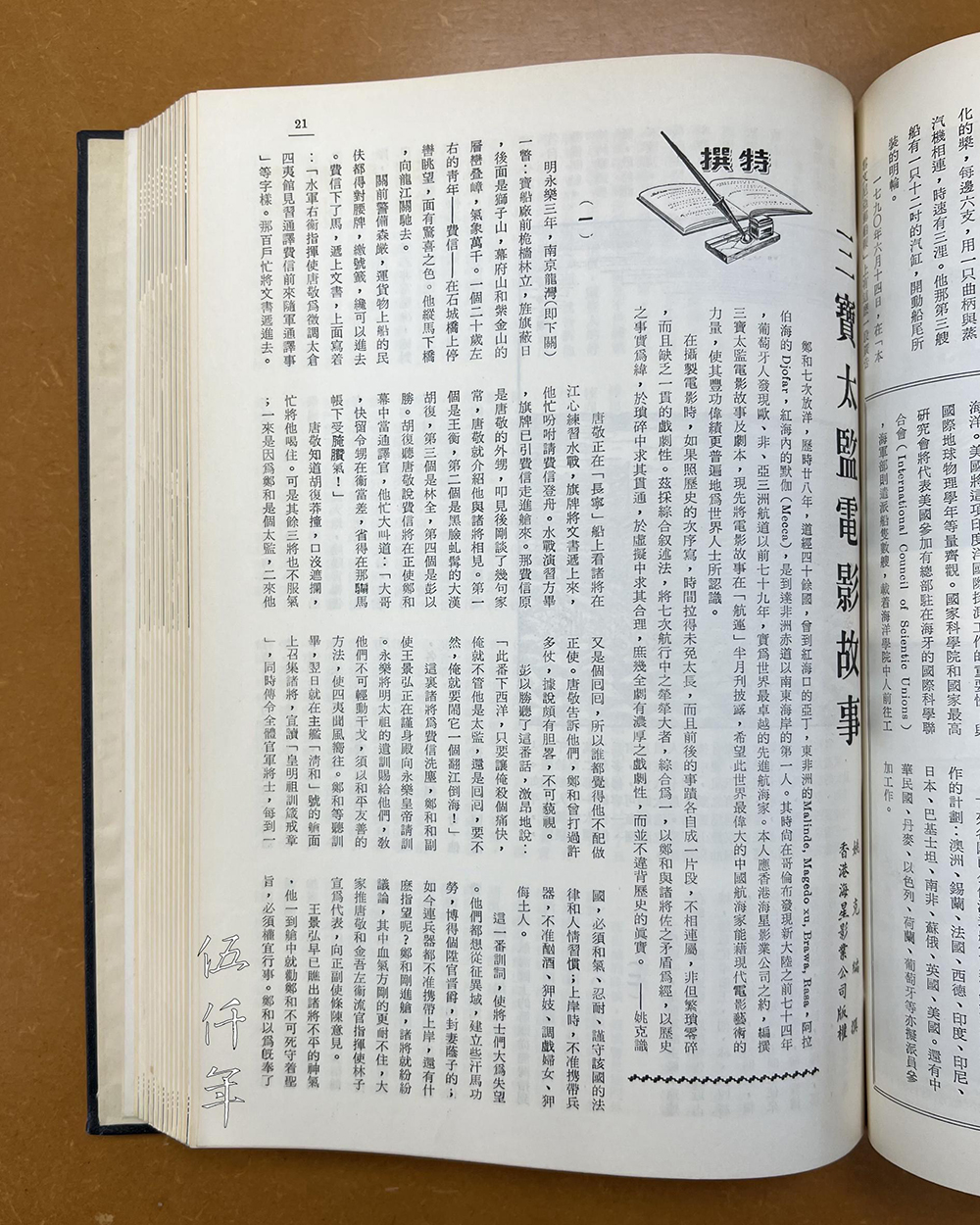
Movie Scenario of Admiral Chen (g) Ho by Uncle Yao K’o published in Issue 189 of Maritime Digest
Uncle Yao K’o (姚克) wrote a summary of the sceenplay titled Movie Scenario of Admiral Chen Ho, which was published on 30 June in the 49th year of the Republic (1960), in Issue Number 189 of the Maritime Digest bi-monthly magazine. At the time my late father Mr. Soong Hsün-leng (宋訓倫) was chief editor of the Maritime Digest.
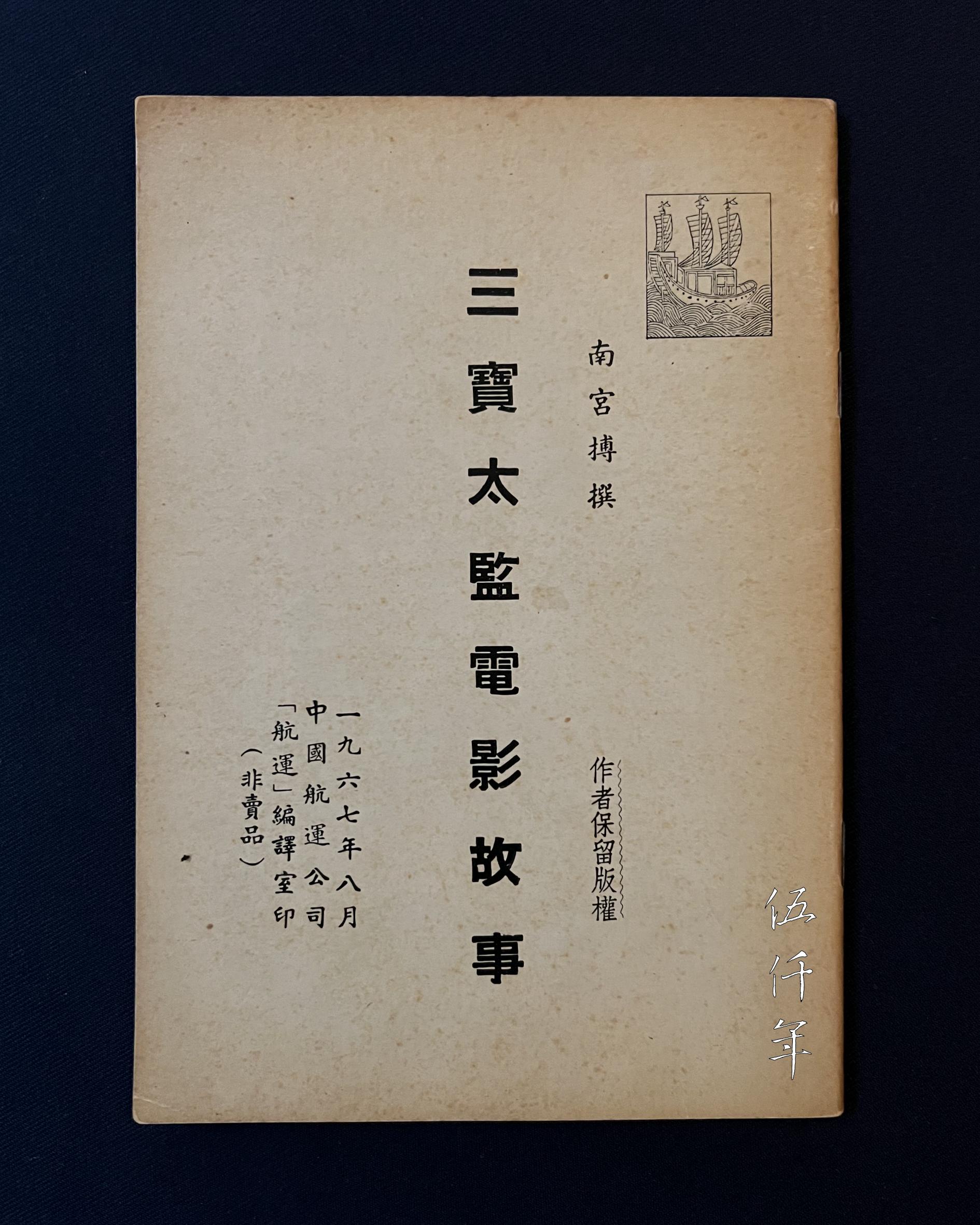
Front cover of Movie Scenario of Admiral Chen Ho by Uncle Ma Pin, nom de plume Nan Kung Po
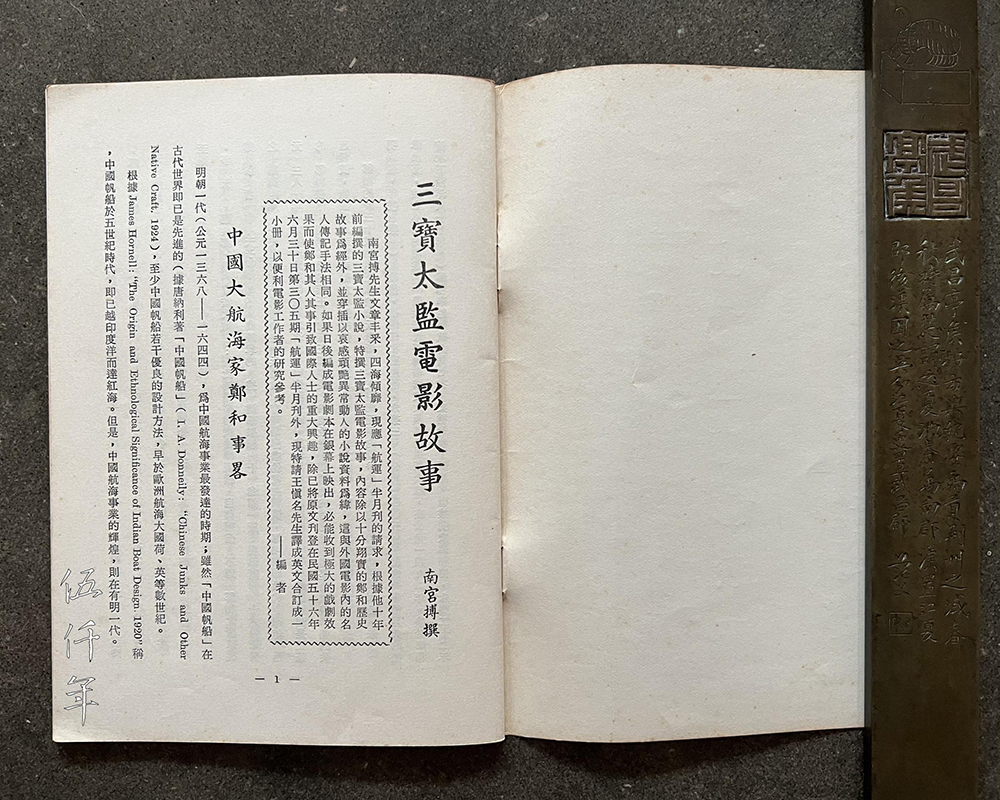
Inside page of Movie Scenario of Admiral Chen Ho by Uncle Ma Pin, nom de plume Nan Kung Po
In another seven years, in August of the 56th year the Republic (1967), Uncle Ma Pin (馬彬) also known as Nan Kung Po (南宮搏) wrote an abridgment based on his new screenplay. It was printed by the Maritime Digest editorial office of the Chinese Maritime Corporation as a bilingual promotional booklet using the same title: Movie Scenario of Admiral Chen Ho. It comes with an English translation by Uncle Wang Shen-ming (王慎名). In March the following year, the complete new screenplay by Uncle Ma Pin (馬彬) was printed by Hong Kong Maritime Film Services Ltd. (香港海星影業公司). The title is First Draft of the Movie Scenario of Admiral Chen Ho. As few copies were printed, it is possible that this single copy found amongst my late father’s belongings is the only extant copy. This almost lost work by Uncle Ma Pin (馬彬) now reappears to the delight of readers everywhere.
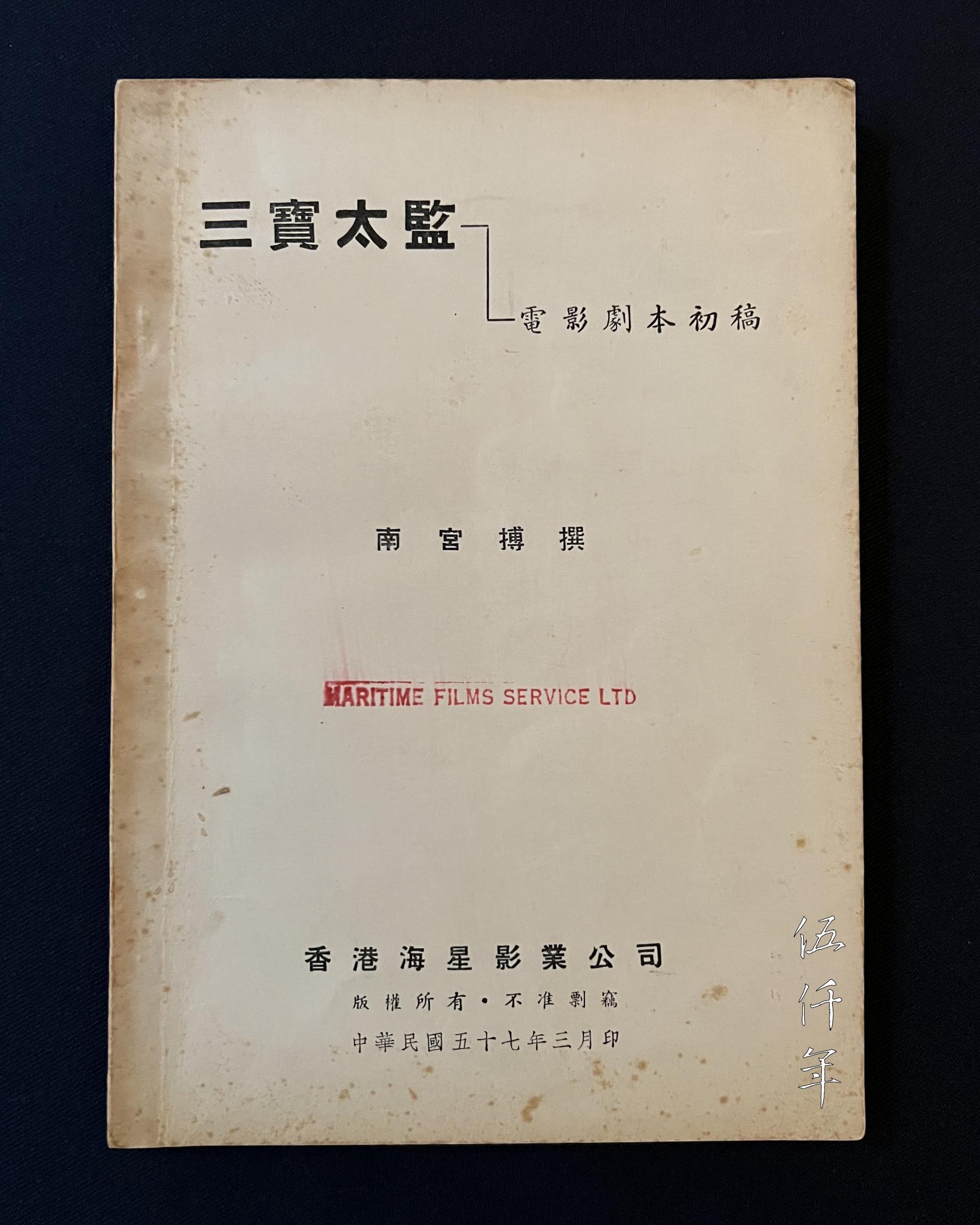
Front cover of First Draft of the Movie Scenario of Admiral Chen Ho
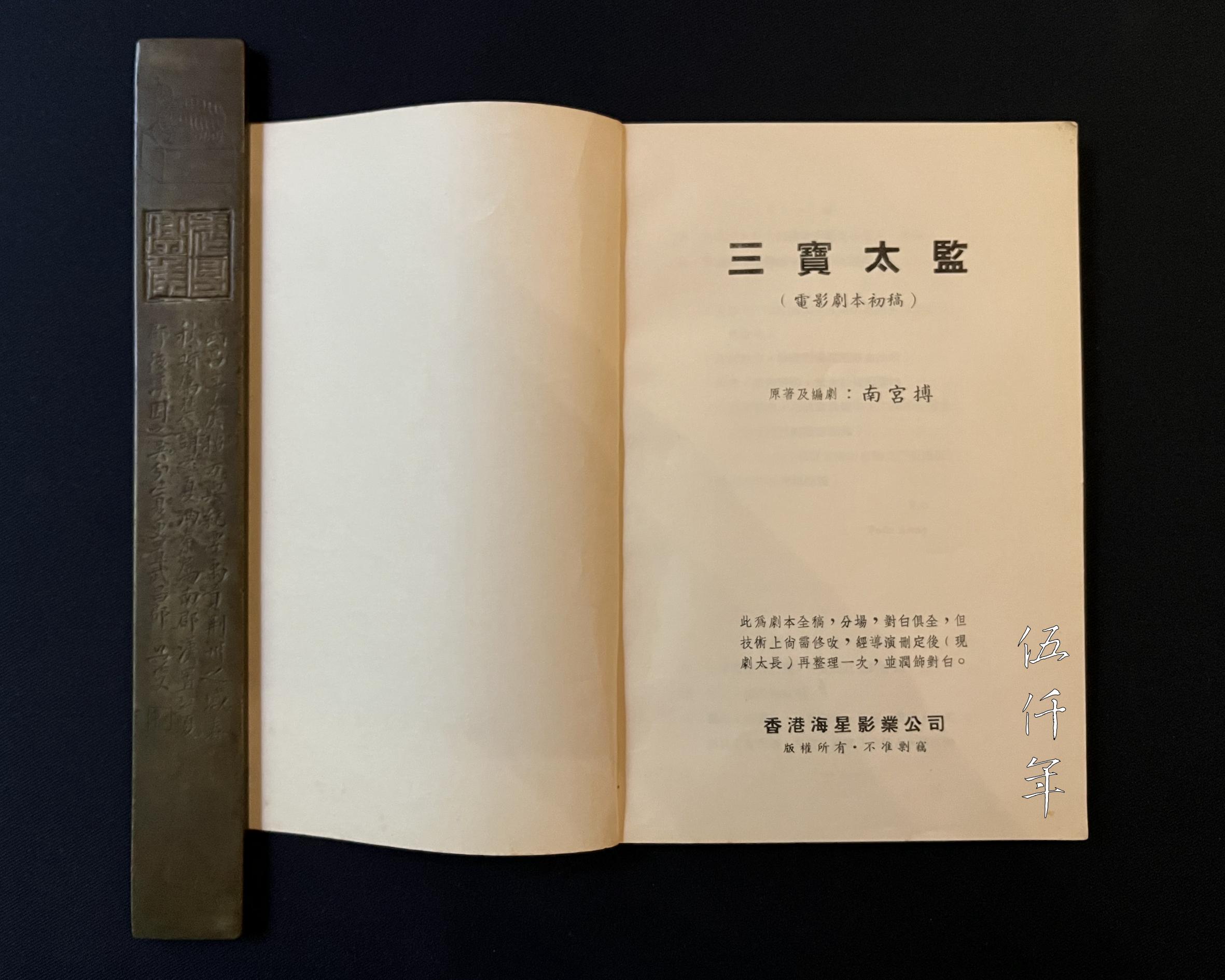
Title page of First Draft of the Movie Scenario of Admiral Chen Ho
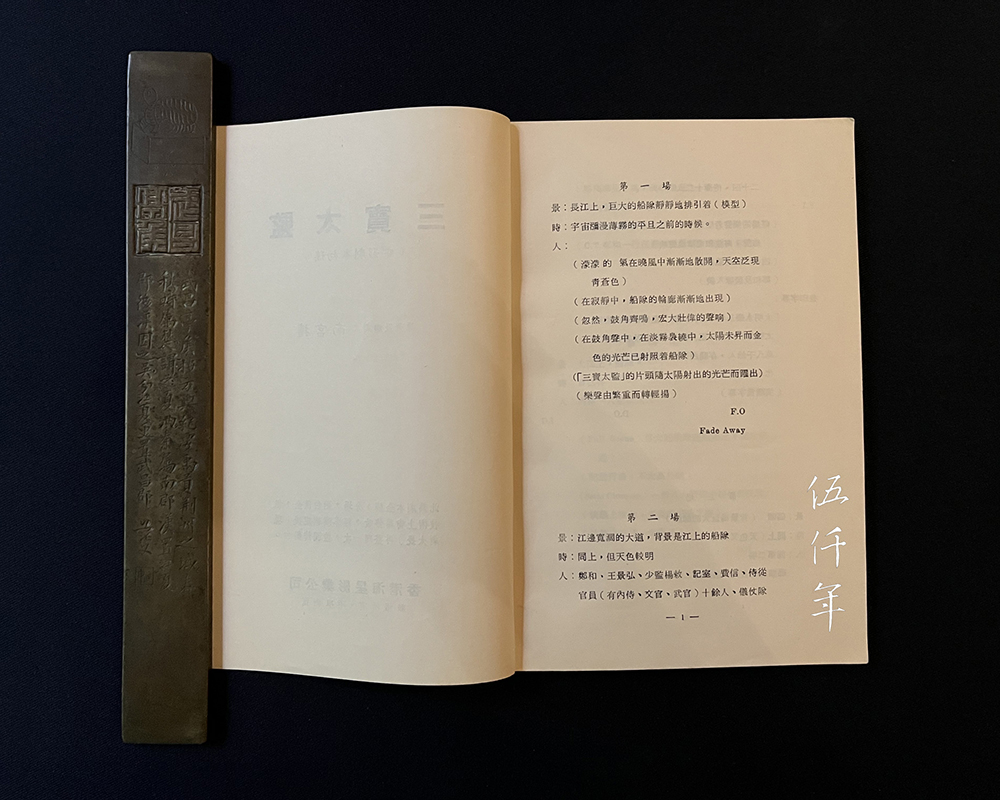
Inside page of First Draft of the Movie Scenario of Admiral Chen Ho
In June of the 71st year of the Republic (1982), the Hong Kong magazine Ta-ch’eng (大成雜誌) published an article written by the Chinese medicine practitioner Uncle Ch’en Ts’un-jen (陳存仁) titled: C. Y. Tung, the Shipping Magnate of a Generation (一代船王董浩雲). Later, this article was reprinted in the book The World of C. Y. Tung (董浩雲的世界), edited by Alice Tung Chien-p’ing (金董建平) and Cheng Hui-hsin (鄭會欣). There is a passage regarding the Movie Scenario of Admiral Chen Ho. It says,
“Mr. Tung knew many people in the artistic circle and wished to make a movie about the eunuch San-pao Cheng Ho. At first, he paid HKD 6,000 to Yao K’o to write an outline of the screenplay. Yao K’o is also a good friend of mine and in order to ensure that the story follow the facts, he borrowed my book The Legacy of Cheng Ho (鄭和遺事). However, Yao K’o was slow, after several reminders, he finally submitted an outline of the screenplay with over a thousand words. Mr. Tung thought his story lacked dramatic appeal, so he asked Ma Pin, (the famous novelist whose nom de plume is Nan Kung Po) to write the screenplay in the form of a novel. Mr. Tung was thrilled when he received the manuscript. He then sought the translation service of Mr. Hsü Hsu (徐訏), president of the Hong Kong English Pen Club, and the screenplay was translated into English. Despite the involvement of three renowned writers, Mr. Tung was still concerned about historical accuracy and asked me to write A Study of the Seven Voyages of the Eunuch San-pao Cheng Ho (三保太監鄭和七次下西洋考). I therefore researched the historical facts and wrote an article which was published serially in Ta-ch’eng magazine.
With this rich material in hand, Mr. Tung at one time considered inviting the famous American actor Yul Brynner to play the role of Cheng Ho. However, Yul Brynner asked for a fee as much as one million US dollars. Mr. Tung thought it was too high, so the matter was put on hold.”
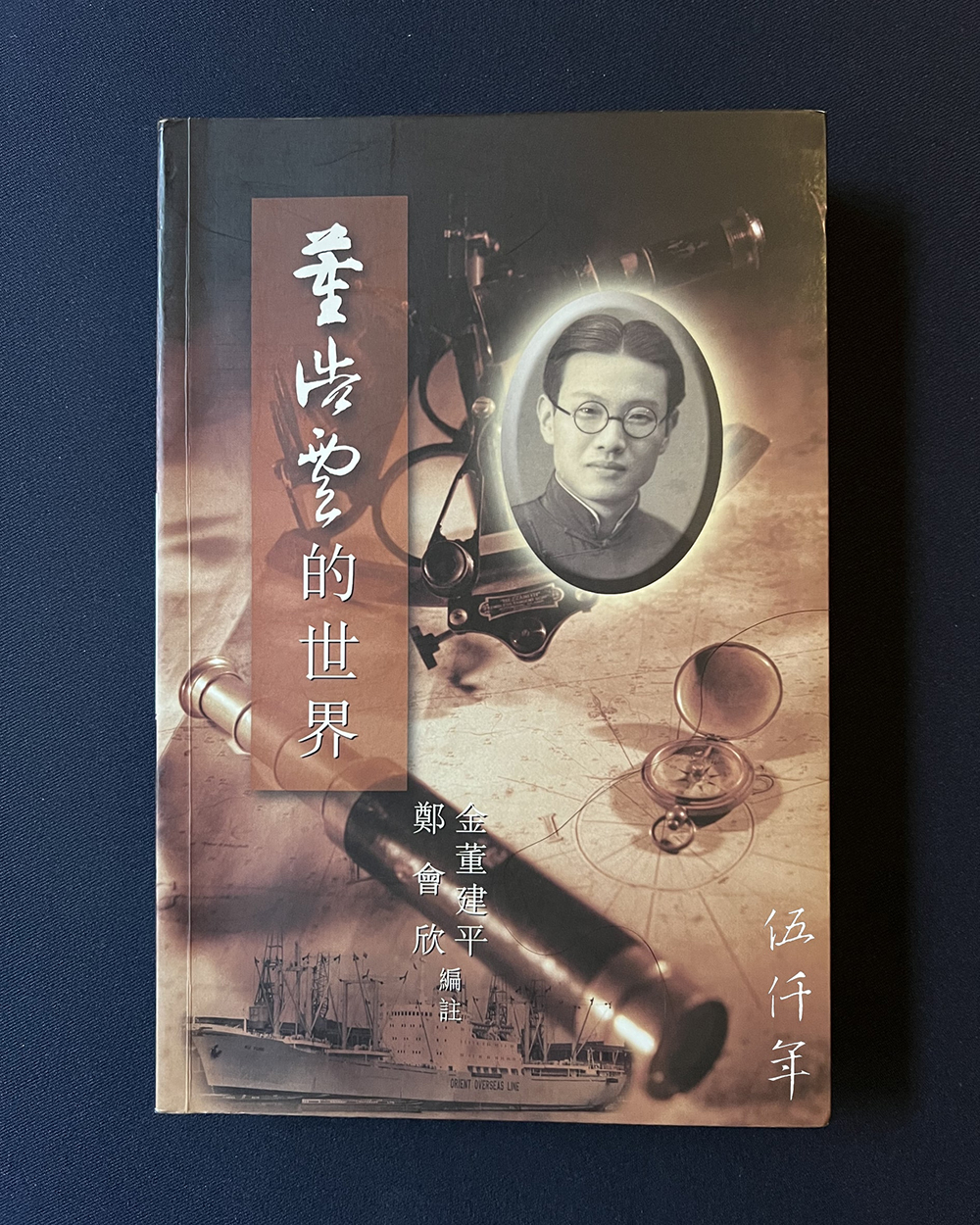
Front cover of The World of C. Y. Tung
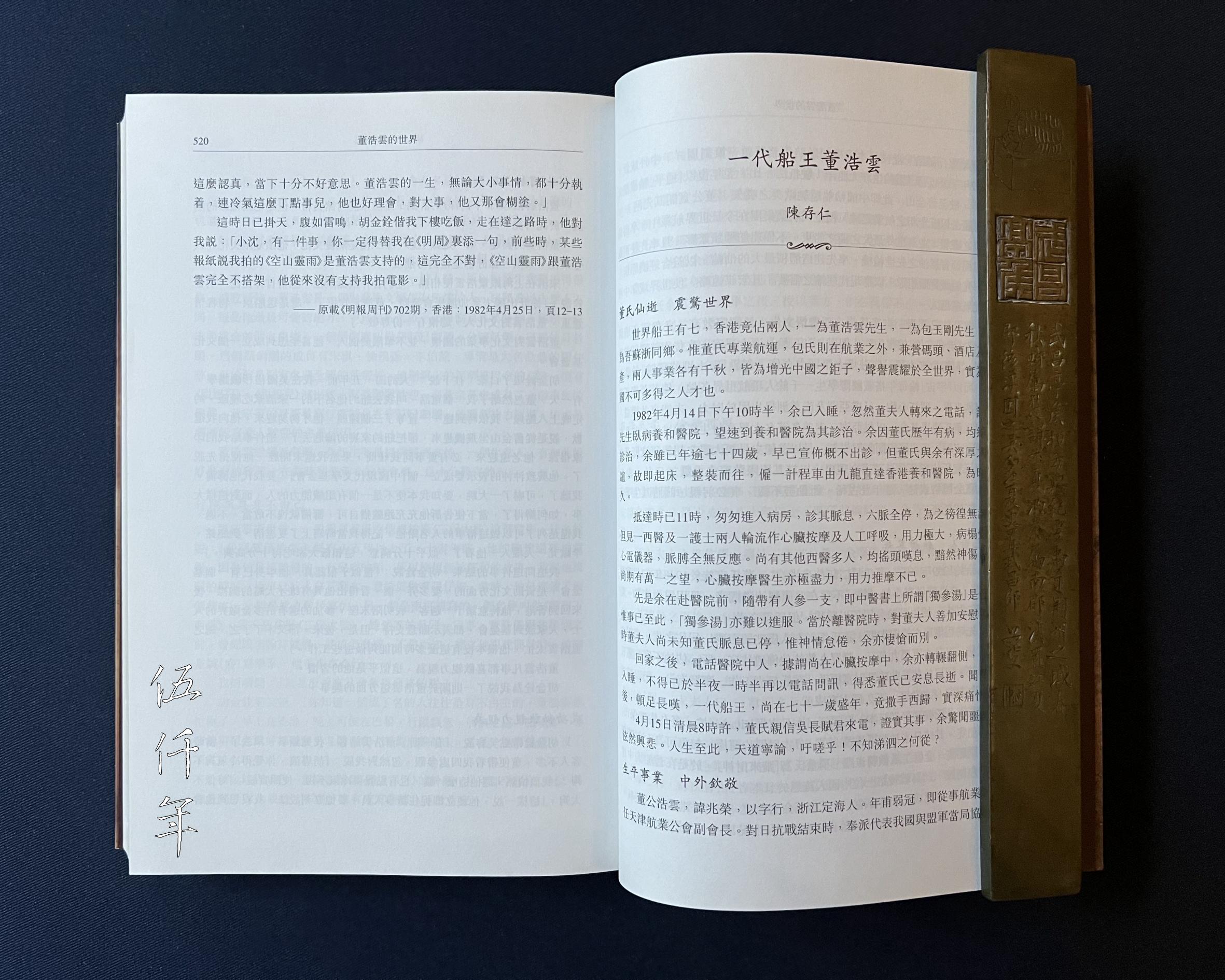
Inside page of The World of C. Y. Tung
The account by Uncle Ch’en Ts’un-jen that Uncle Yao K’o “submitted an outline of the screenplay with over a thousand words” is not accurate. His outline for Movie Scenario of Admiral Chen Ho contains a total of 10,283 words and punctuations.
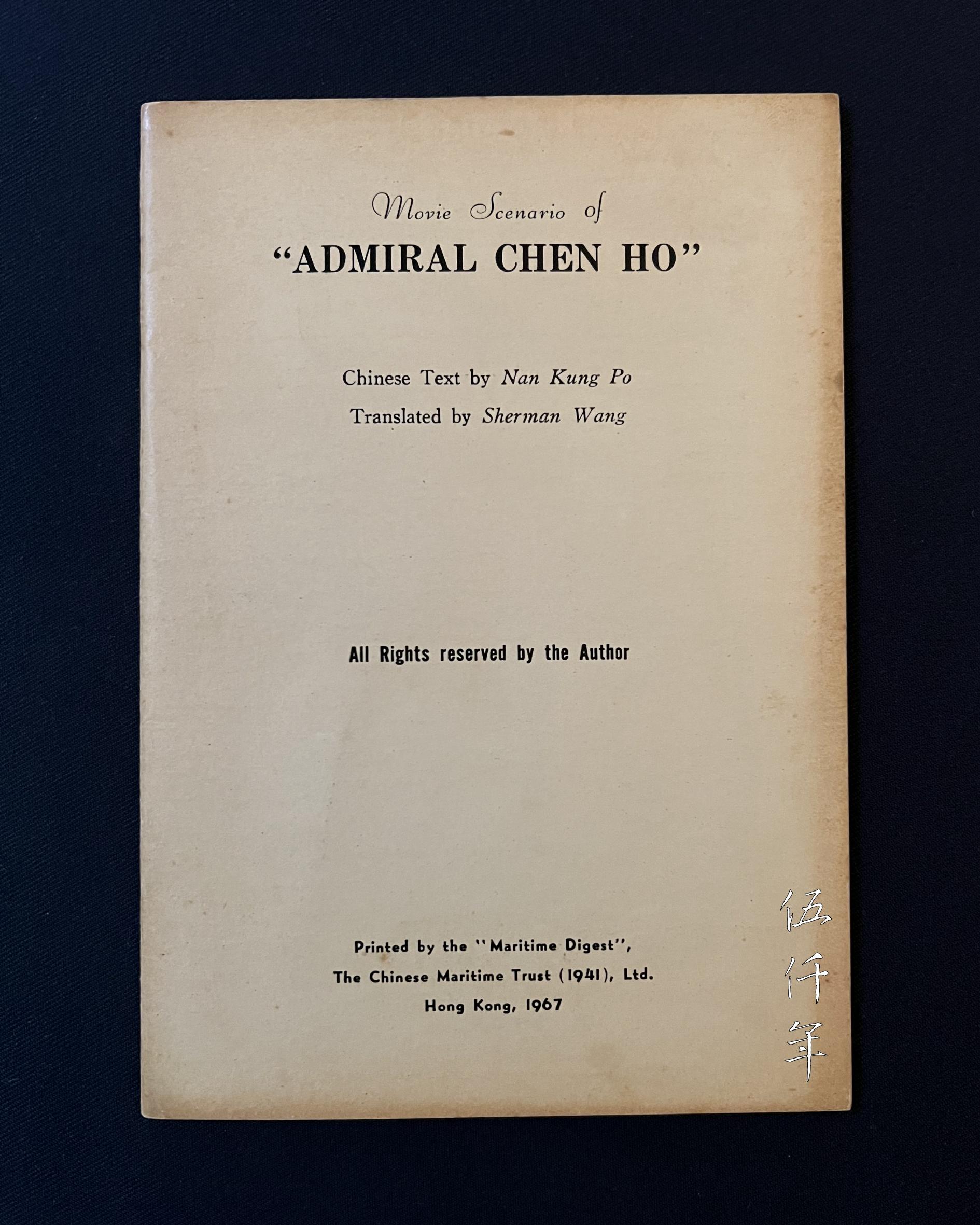
Back cover in English of Movie Scenario of Admiral Chen Ho by Uncle Ma Pin, nom de plume Nan Kung Po
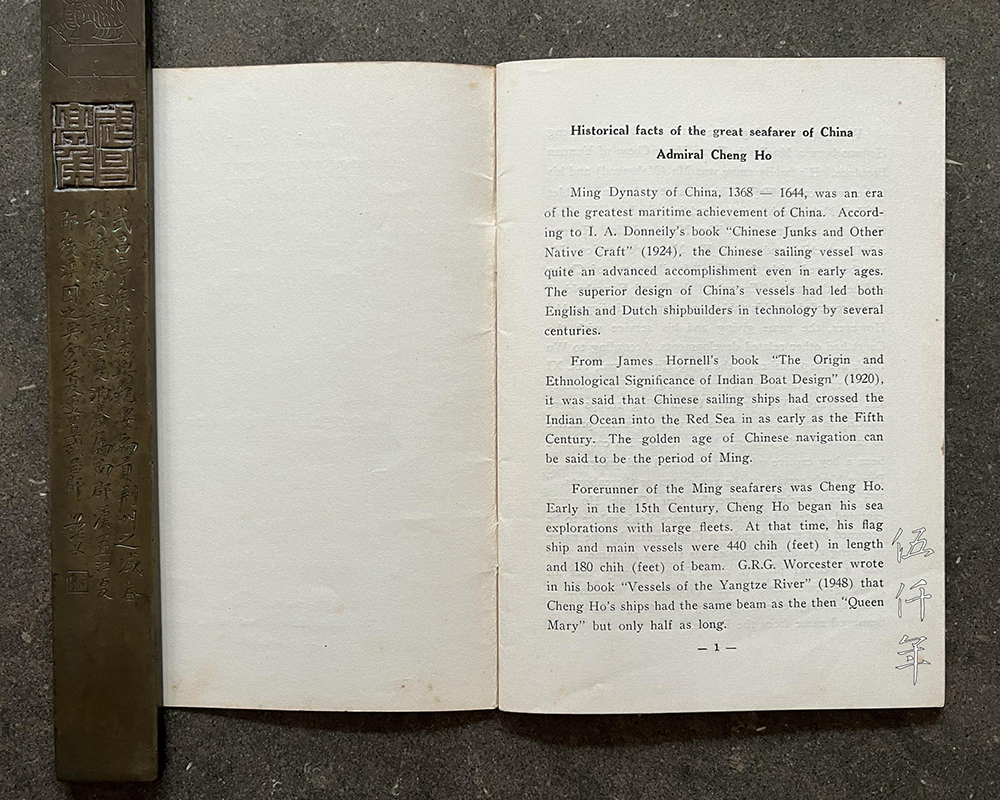
Inside page in English of Movie Scenario of Admiral Chen Ho by Uncle Ma Pin, nom de plume Nan Kung Po
It is also not true that “He then sought the translation service of Mr. Hsü Hsu, president of the Hong Kong English Pen Club, and the screenplay was translated into English.” It is unclear the source of his claim. The front cover of Movie Scenario of Admiral Chen Ho by Nan Kung Po has two small printed lines in English, stating:
Chinese text by Nan Kung Po (南宮搏撰)
Translated by Sherman Wang (王慎名翻譯)
Uncle Sherman Wang Shen-ming was an erudite diplomat of the Republic of China, proficient in both Chinese and English languages. At one time, he was stationed in Japan, and travelled frequently to Hong Kong.
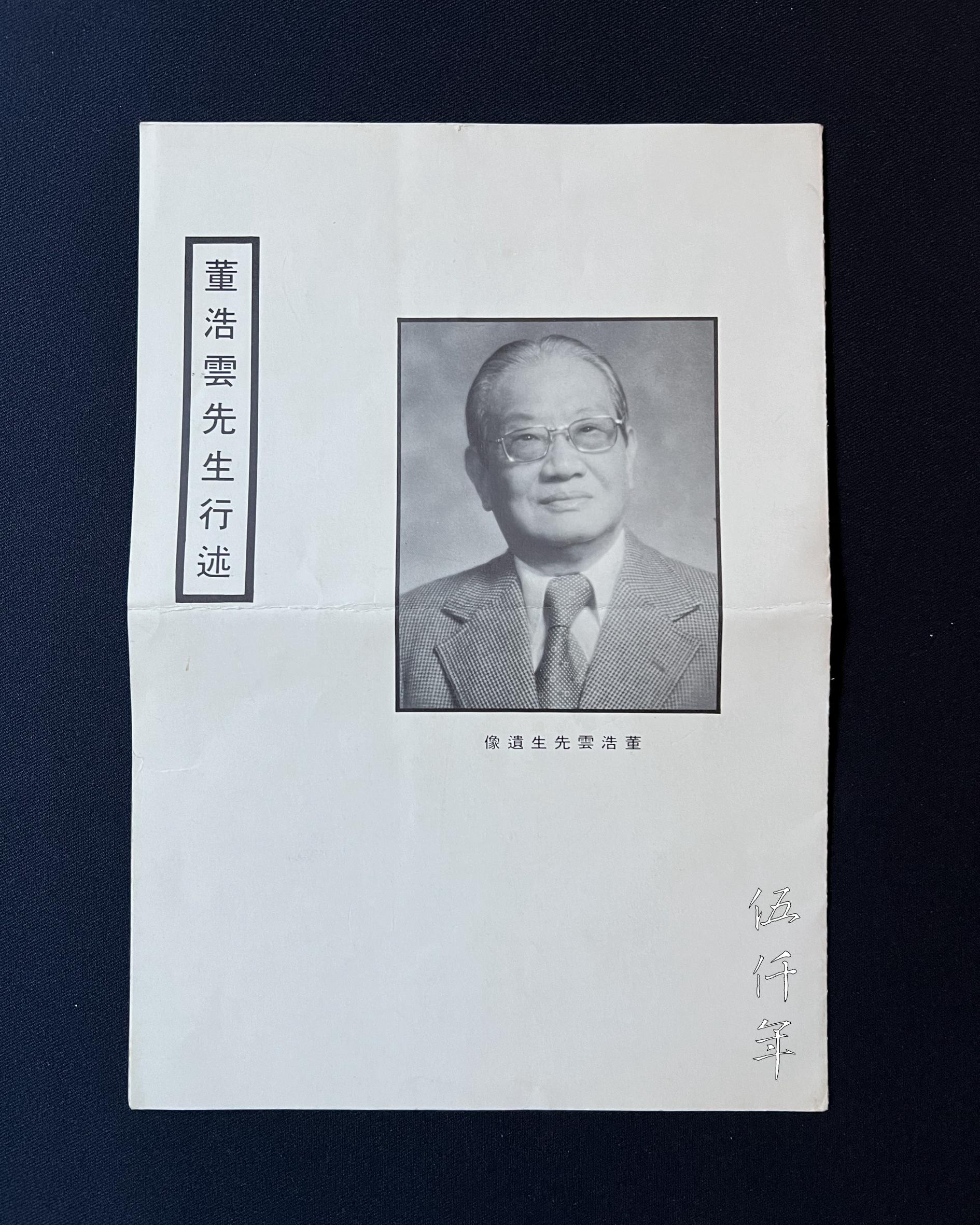
Front cover of the funeral booklet Life of Mr. C. Y. Tung
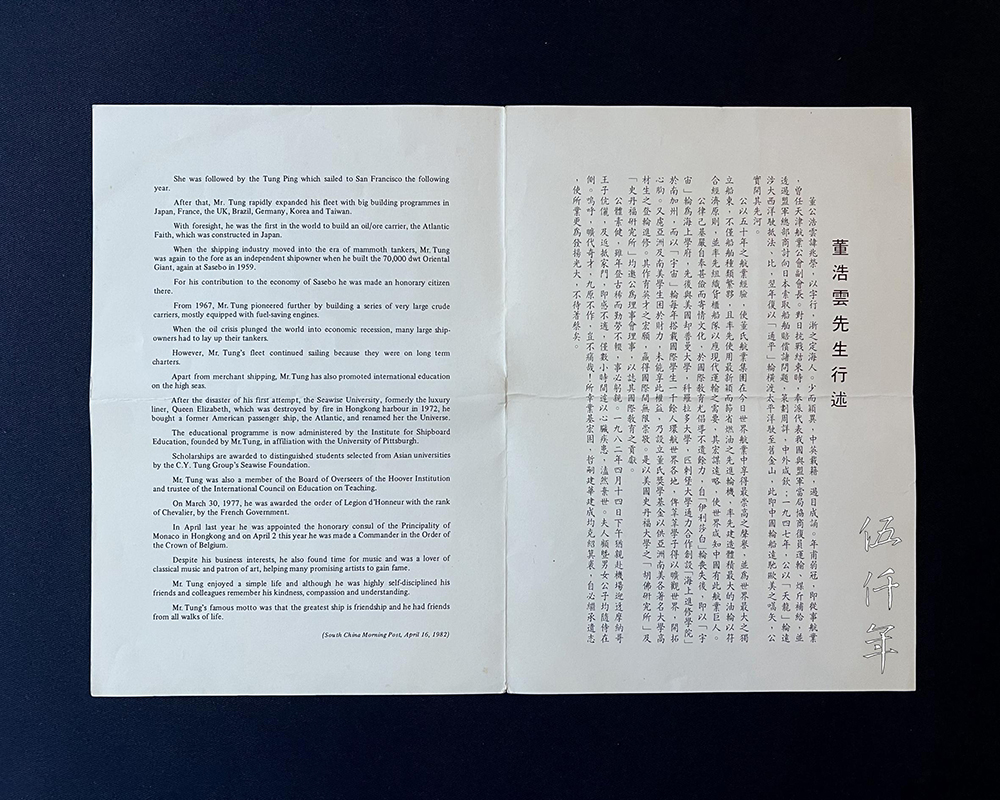
Inside page of the funeral booklet Life of Mr. C. Y. Tung
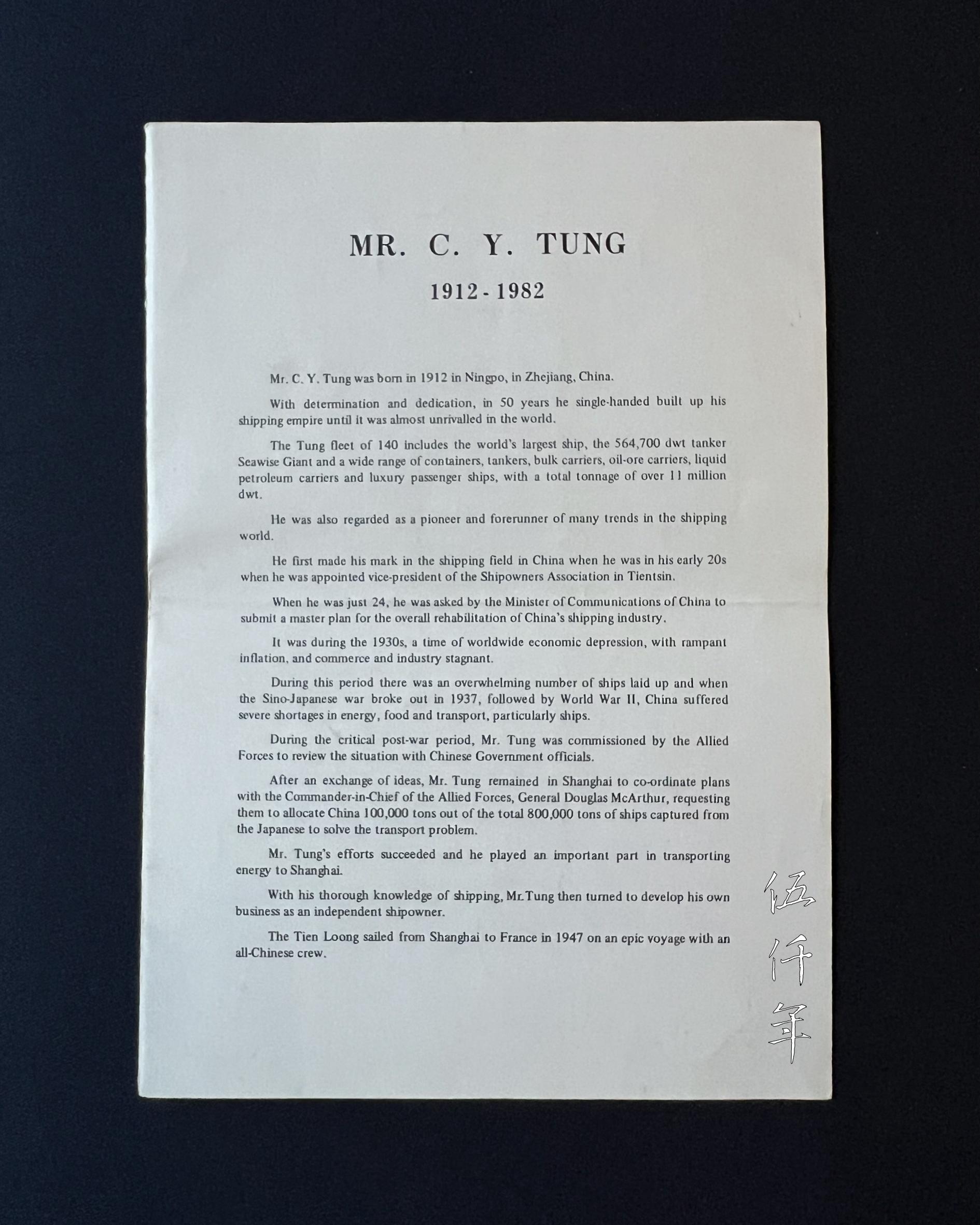
Back cover of the funeral booklet Life of Mr. C. Y. Tung
Uncle C. Y. Tung (1912-1982) was originally named Chao-yung (兆榮). His English abbreviations C.Y. were derived from the original name. However to Chinese he was known as Tung Hao-yün (董浩雲). His family was from Ting-hai (定海), Chekiang Province, but he was born in Shanghai. In the 29th year of the Republic of China (1940), he founded the Chinese Maritime Trust Company (中國航運信託公司), and in the following year, he registered the company in Hong Kong. In December of the 30th year of the Republic (1941), when the Japanese occupied the Shanghai Concessions and Hong Kong, his company came under Japanese control. In the 34th year of the Republic (1945), China came out victorious in the War of Resistance Against Japanese Aggression. In the following year he established the Chinese Maritime Company (中國航運公司). In the 38th year of the Republic (1949), as mainland China fell to the communists, he followed the government to Taiwan. In the 48th year of the Republic (1959), he became one of Asia’s pioneering shipowners to construct large oil tankers. In the 62nd year of the Republic (1973), he established the Orient Overseas Container Line (東方海外貨櫃航業公司) in Hong Kong. Uncle Tung's fleet comprised 150 large vessels. In the 59th year of the Republic (1970), he acquired the ocean liner “Queen Elizabeth” and renamed it “Seawise University”, and became the first ever seaborne university in history. Apart from his talent in shipping, he was also deeply dedicated to cultural endeavors.
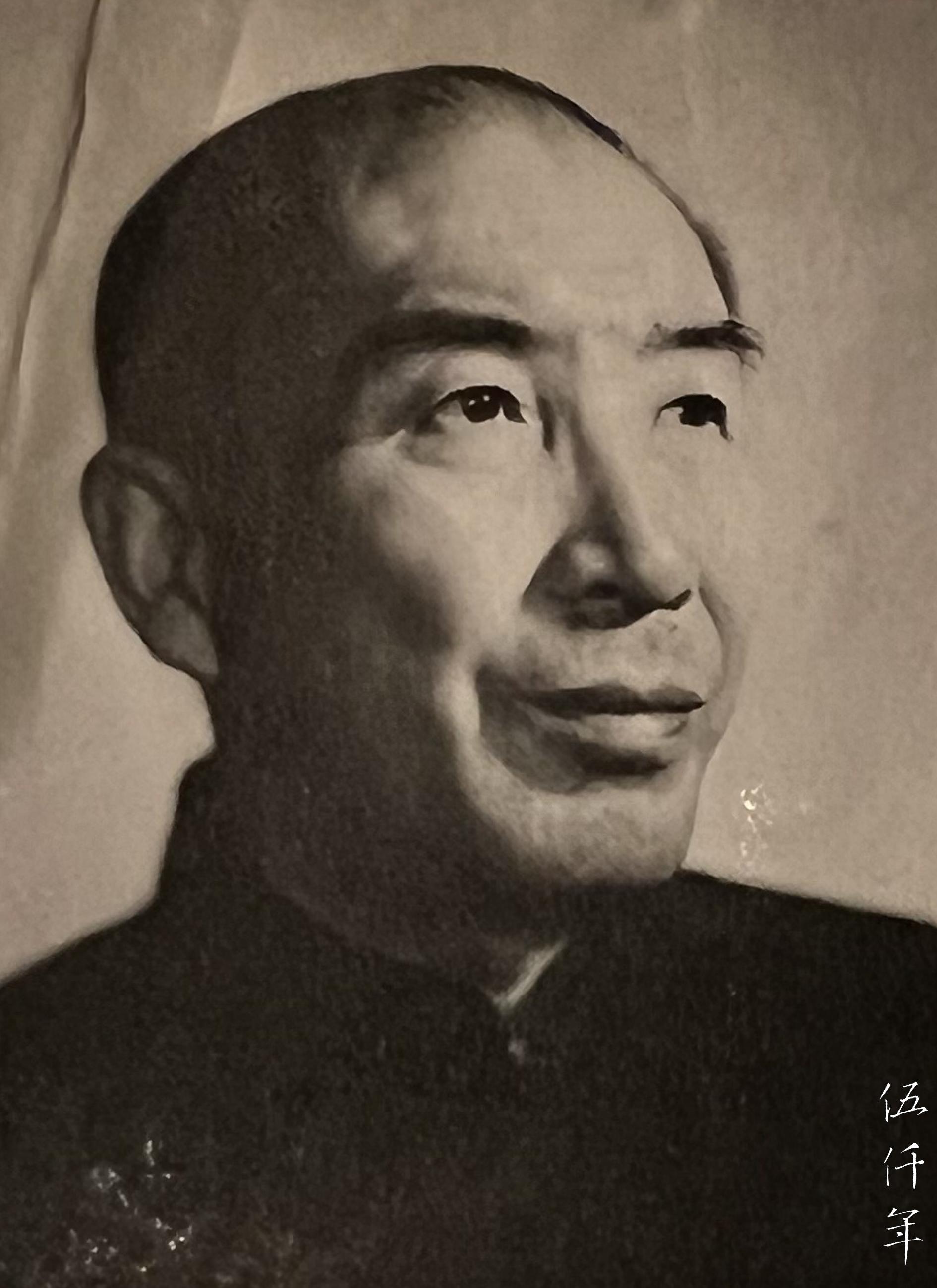
Portrait of Uncle Yao K’o
Uncle Yao K’o (姚克 1905-1991) was originally named Chih-i (志伊), he was also known as K’o (克), tzu Hsin-nung (莘農). He was a native of Anhui Province, but born in Hsia-men. In the 20th year of the Republic (1931), he graduated from Soochow University (東吳大學) and worked at the World Book Company (世界書局) in Shanghai, responsible for editorial work and translation. In the 24th year of the Republic (1935), he served as editor for the English monthly magazine T’ien Hsia (天下) . In the 26th year of the Republic (1937), he was editor for the English monthly magazine Democracy (民主). In the 27th year of the Republic (1938), he went to Yale University in the United States as a researcher at the School of Drama. In the 29th year of the Republic (1940), he returned to Shanghai to teach at Fudan University (復旦大學) and St. John's University (聖約翰大學). In the 36th year of the Republic (1947), he was English editor at the Central News Agency (中央社). In the 38th year of the Republic (1949), as mainland China fell to the communists, he moved to Hong Kong and worked as a movie scriptwriter. In the 45th year of the Republic (1956), he taught at New Asia College. (新亞書院), and in the 50th year of the Republic (1961), he taught at the Chinese Department of United College (聯合書院). In the 58th year of the Republic (1969), he was recruited by the University of Hawaii and settled in the United States. In his life time, he produced a large amount of works. His screenplay was particularly singled out and attacked by the Chinese Communist Party on 30 March 1967 with an article titled: Patriotism or Treachery? – A Critique of the Historical Film Malice of Empire (愛國主義還是賣國主義?- 評歷史影片清宮秘史). He was renowned for his spirited counterattack. Commentators all praised him for his moral courage as an intellectual.
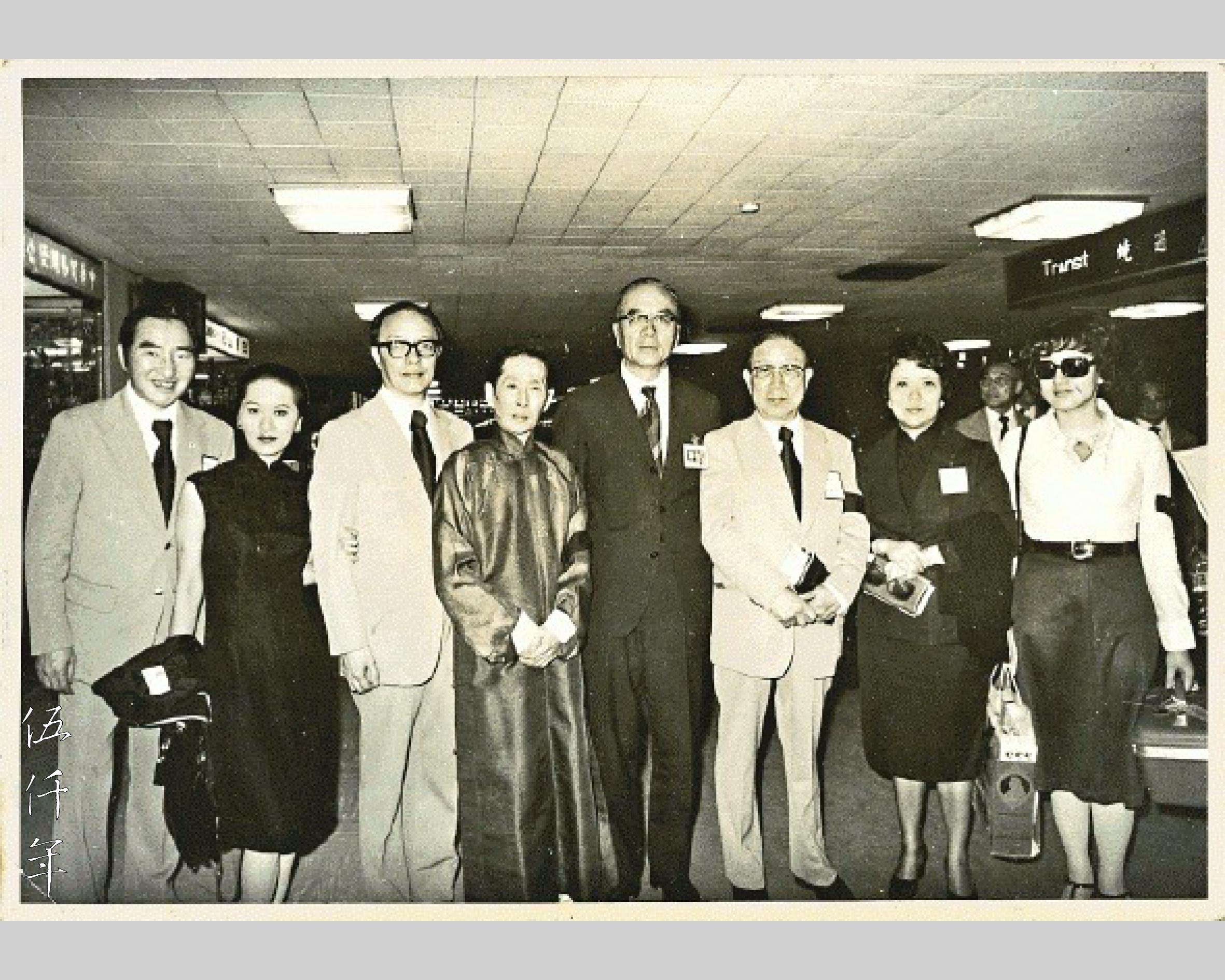
Representatives from Hong Kong arriving at Sung-shan Airport, Taipei, to attend the Funeral Service of President Chiang Kai-shek in the 64th year of the Republic (1975). Uncle Ma Pin standing first on the left
Uncle Ma Han-yüeh (馬漢嶽 1924 -1983), was originally named Pin (彬), his pen names were Nan Kung Po (南宮搏), Shih-chien (史劍), Hsu-chien (許劍), Ma-ping (馬兵), Pi-kuang (碧光) and Ch’i-chien (齊簡). He was a native of Yuyao (餘姚), Chekiang Province. He graduated from Chekiang University (浙江大學) and served as editor and chief editor for Sao-t’ang Pao (掃蕩報) in Wuhan, Ho-p’ing Jih-pao (和平日報) in Ch’ung-ch’ing, and Ho-p’ing Shi-pao (和平時報) in Shanghai. In the 38th year of the Republic of China (1949), as mainland China fell to the communists, he went to Taiwan to manage Cheng-hsin Hsin-wen Pao (徵信新聞報). Later he became director of China Times (中國時報). He gained acclaim for his historical novels and authored more than sixty works.
In my collection, there is a precious album with the essay Inception (緣起) written by my late father Mr. Soong Hsün-leng. The essay Inception was used for fundraising of the Cheng Ho movie. It is a classical composition in the literary form of p’ien-wen (駢文) , or rhythmical prose. The calligraphy is in the style of small regular script, also by my late father, executed in the 43rd year of the Republic (1954). Following the essay Inception, there is The Simple Prospectus of Four Seas Film Corporation Ltd., also composed and hand-written by my late father. At the end of which are the signatures of four persons: Mr. Yang Kuan-pei (楊管北), Uncle C. Y. Tung (董浩雲), Mr. Hsü Pao-hua (許寶驊), and Mr. Li Chih-i (李志一). One can surmise the company was named Four Seas Film Corporation Ltd. (四海影業股份有限公司) during the stage of fundraising, but after failing to fundraise, Uncle C. Y. Tung funded the project on his own, and the company was renamed Maritime Film Services Ltd. (海星影業公司).
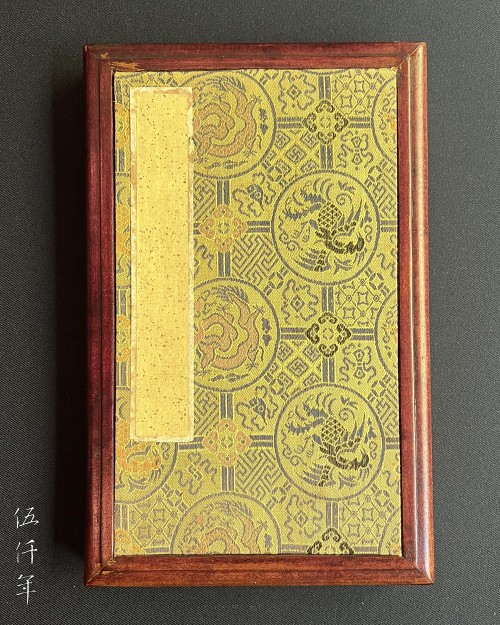
Album containing the essay Inception and The Simple Prospectus of Four Seas Film Corporation Ltd. composed and handwritten by my late father Mr. Soong Hsün-leng
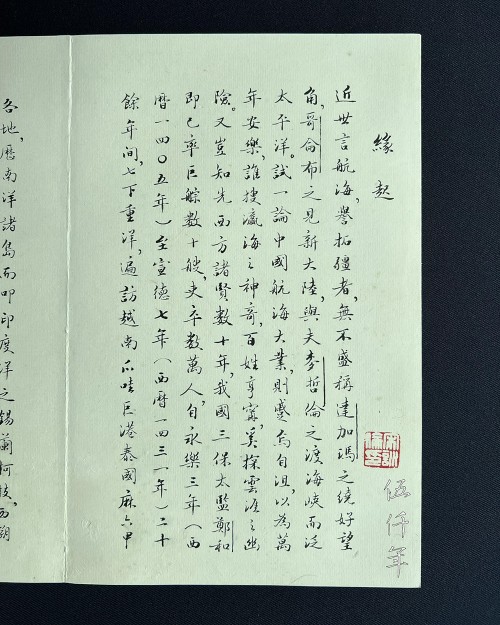
First page of Inception composed and handwritten by my late father Mr. Soong Hsün-leng
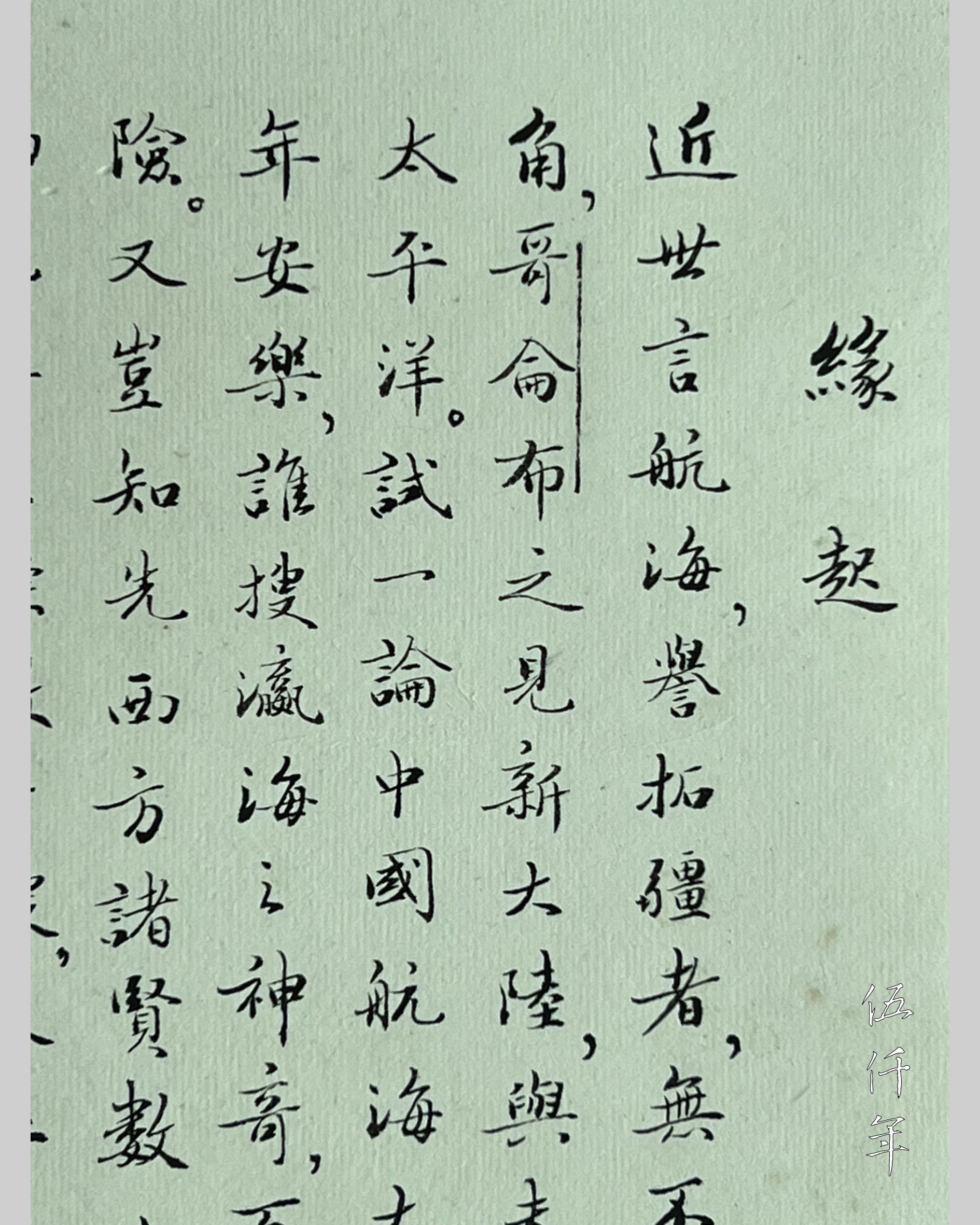
Detail of first page of Inception composed and handwritten by my late father Mr. Soong Hsün-leng
The text of the essay Inception (緣起) reads:
“In modern times, whenever people speak of ocean navigation and applaud the explorations of new territories, everyone pays tributes to Vasco da Gama for navigating the Cape of Good Hope, Christopher Columbus for discovering the New World, and Ferdinand Magellan for crossing the strait to sail the Pacific Ocean.
However If one tries to discuss China’s great maritime achievements, one becomes hesitant and dejected. It is assumed that having lived through long periods of peace and contentment, who will seek the wonders of the boundless oceans? It is assumed that having fulfilled their desires, who will explore the remote and solitary dangers of cloud covered mountains? Who would have known that decades before the pioneers of the West, our compatriot Admiral Cheng Ho already led dozens of enormous vessels with crews of tens of thousands, made seven ocean voyages from the 3rd year of the Yung-le reign (1405) to the 7th year of the Hsüan-te reign (1432) over a period of more than twenty years.
He extensively visited Vietnam, Java, Palembang, Siam, Malacca, travelled through the islands of the South Seas, before reaching the shores of Ceylon and Kochi in the Indian Ocean. Sailing westwards to the Red Sea, he arrived at Mecca, then voyaged south to Africa, reaching the shores of Madagascar. His voyages covered tens of thousands of nautical miles. He conveyed the edicts of the imperial court to pacify more than forty countries.
During his diplomatic expeditions to all these various countries, he promoted the power and benevolence of China, quelled rebellions and restored order. He defeated Ch’en Tsu-i (陳祖義) bringing peace to Palembang, conciliated with Tuban (都馬板) and stabilized Java, arrested Alagakkonara (亞烈苦) leading to the establishment of friendly ties with Ceylon, earned the gratitude of Indonesia by subjugating Sekandar (蘇幹剌). His achievements were many and glorious, leaving lasting impact in history.
As for the gifts and honours bestowed along the voyages and the proclamations of the grace and benevolence of China, the odes to frontier accomplishments and their commemorative steles remain intact. To this day, they can be found in the regions of the South Seas and India, bearing witness to historical records.
To the places where his reputation and teachings spread, forty nations either presented rare treasures and pledged fealty, or offered tribute as a gesture of sincere deference. It was truly a bright and splendid time between China and foreign countries, and peace and harmony in East Asia. It can be called a prosperous age.
As for the magnificence of the fleet, the thoroughness of the organization, the distances covered, and the duration of the voyages, they went far beyond the imagination of those few explorers of the West. Further, the voyages served as both cultural and diplomatic missions, prioritizing peaceful engagement over political and military action. If it were not for their remarkable maritime expertise, how could they have paved way for today’s naval escorts?
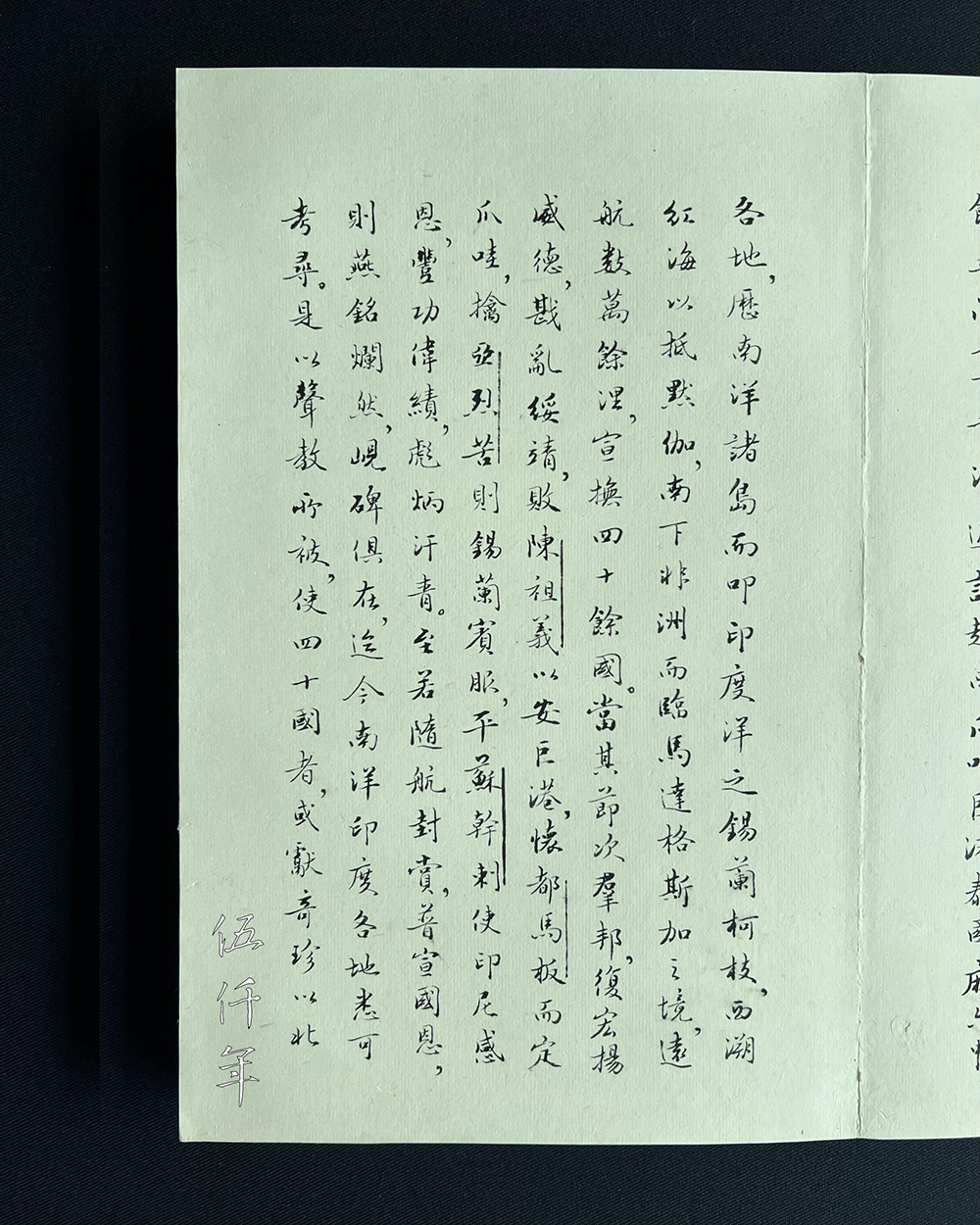
Second page of Inception composed and handwritten by my late father Mr. Soong Hsün-leng
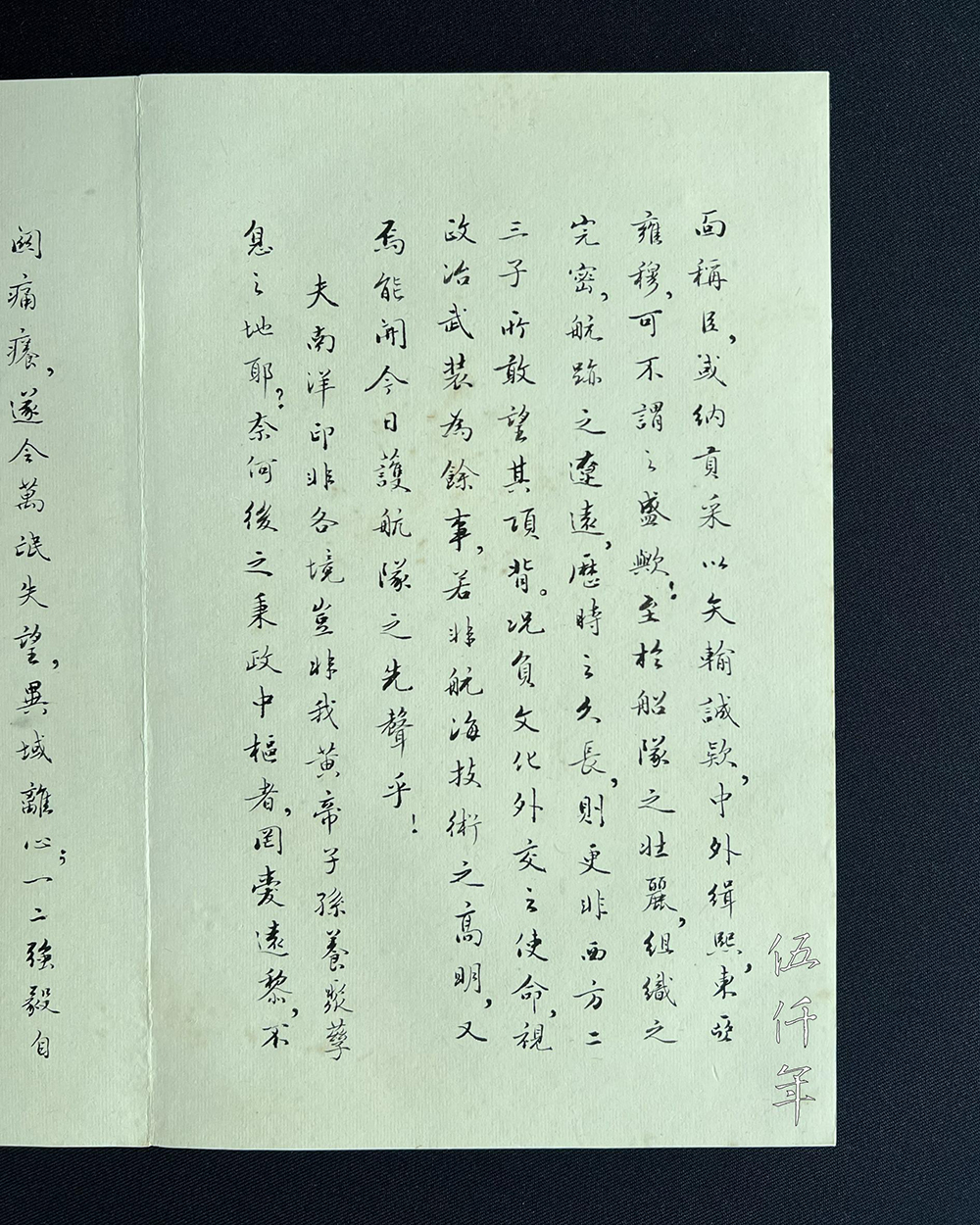
Third page of Inception composed and handwritten by my late father Mr. Soong Hsün-leng
Indeed, are not the regions of the South Seas, India, Africa and such lands places where Chinese people have settled and flourished? Unfortunately, in later times those who hold power in government fail to show concern and empathy for their people in distant lands, and have nothing to do with them, resulting in disappointment to tens of thousands, and those who reside in foreign countries feel disconnected. A few strong-willed and self-confident clans ventured to develop their new frontiers, and became formidable adversaries. However they are from the same stock and share a common origin.
In recent times, the turmoils in mainland China are causing widespread sufferings and hardships. Their reckless initiation of wars have only intensified grievances and discontent. Reflecting on the present and recalling the past, one is overwhelmed by loss and melancholy.
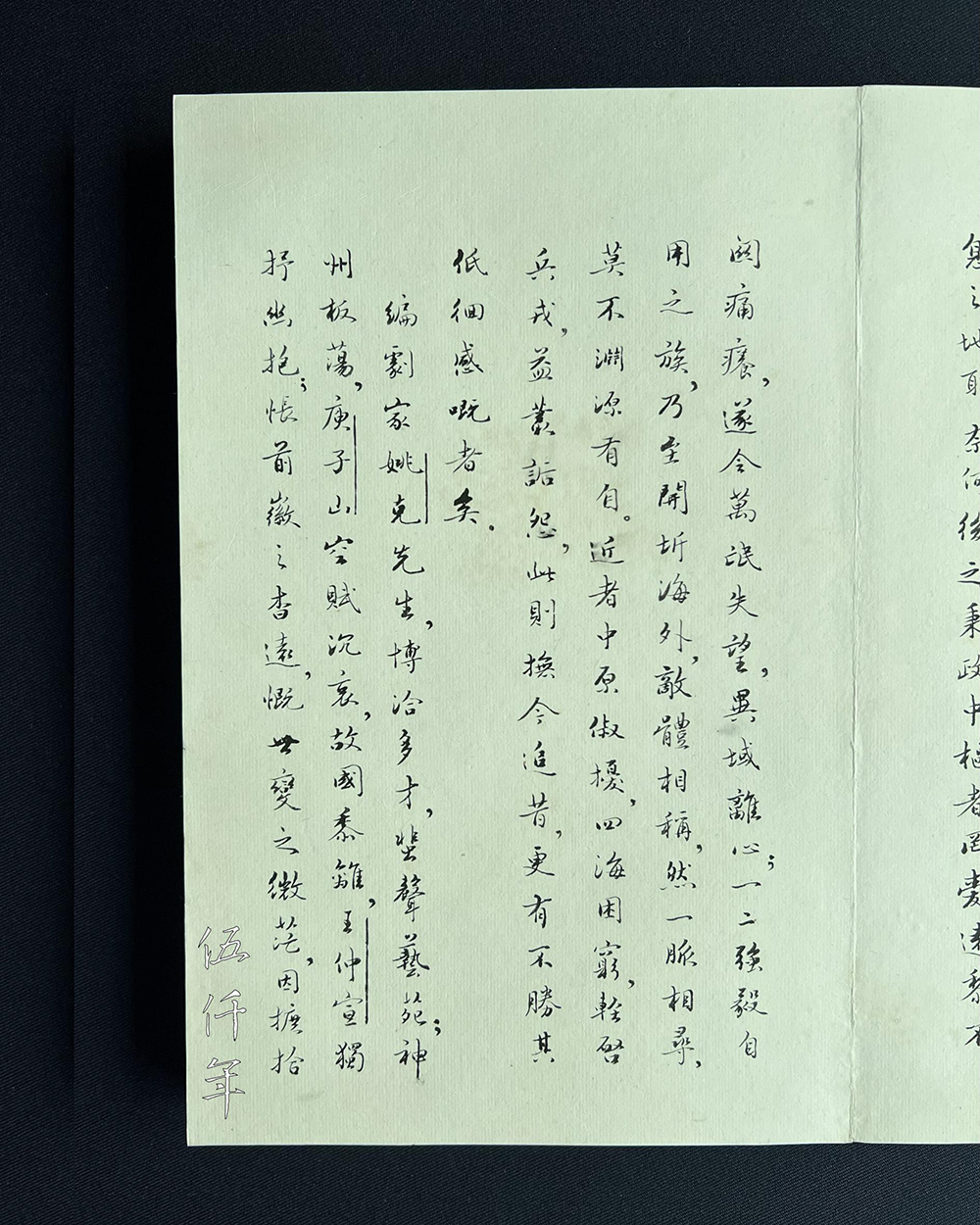
Fourth page of Inception composed and handwritten by my late father Mr. Soong Hsün-leng
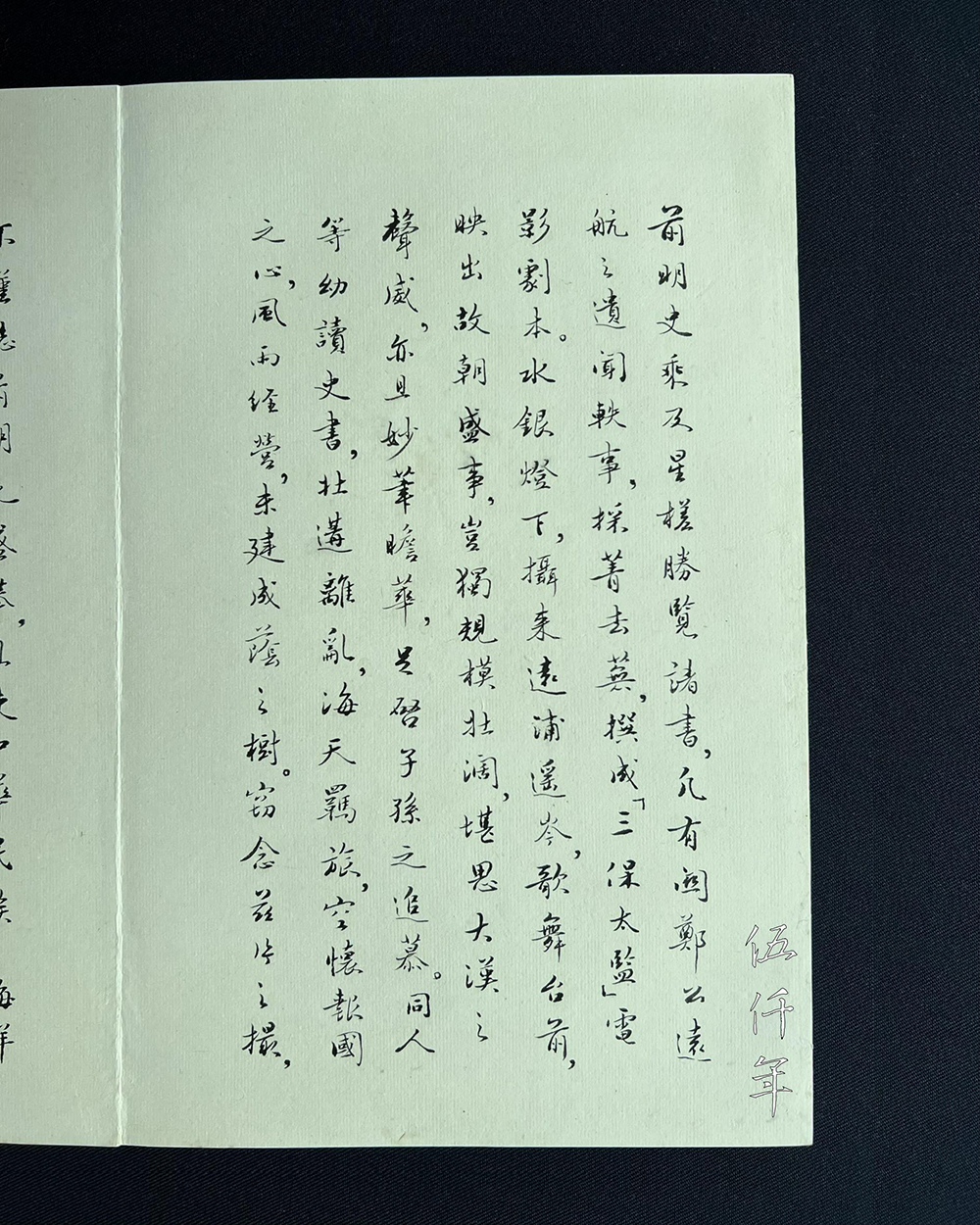
Fifth page of Inception composed and handwritten by my late father Mr. Soong Hsün-leng
The playwright Mr. Yao K’o is a talented and versatile man, renowned in artistic circles. In the midst of our country’s mayhem, he is like Keng Hsin (庚信 513-581) lamenting his profound grief. In the midst of our country’s fall, he is like Wang Ts’ai (王粲 177-217) articulating his lonesome sentiments. Dismayed by the distancing of the past, bemoaning the uncertainties of upheavals, he gathers the books on the history of the Ming dynasty, as well as a volume of Hsing-ch’a-sheng-lan (星槎勝覽), meticulously he sifted through all the stories and anecdotes concerning the voyages of Admiral Cheng Ho, separating the grain from the chaff, and writing the screenplay for the Movie Scenario of Admiral Chen Ho.
Under cinematic lighting, the camera will capture the distant shores and the remote peaks. On the performing stage, songs and dance will depict the remarkable achievements of our former country. It is not just about grandiose scale, it will evoke our memories of the majesty of the great Han empire. The delightful presentation itself will be sufficient to inspire admiration and reverence from future generations.
For those of us who studied history in our childhood, we are now encountering turmoil and separation in our adulthood, becoming wanderers in this world. Our earnest aspirations to serve the country have been in vain, working against the tempest, our efforts have yet to bear fruit.
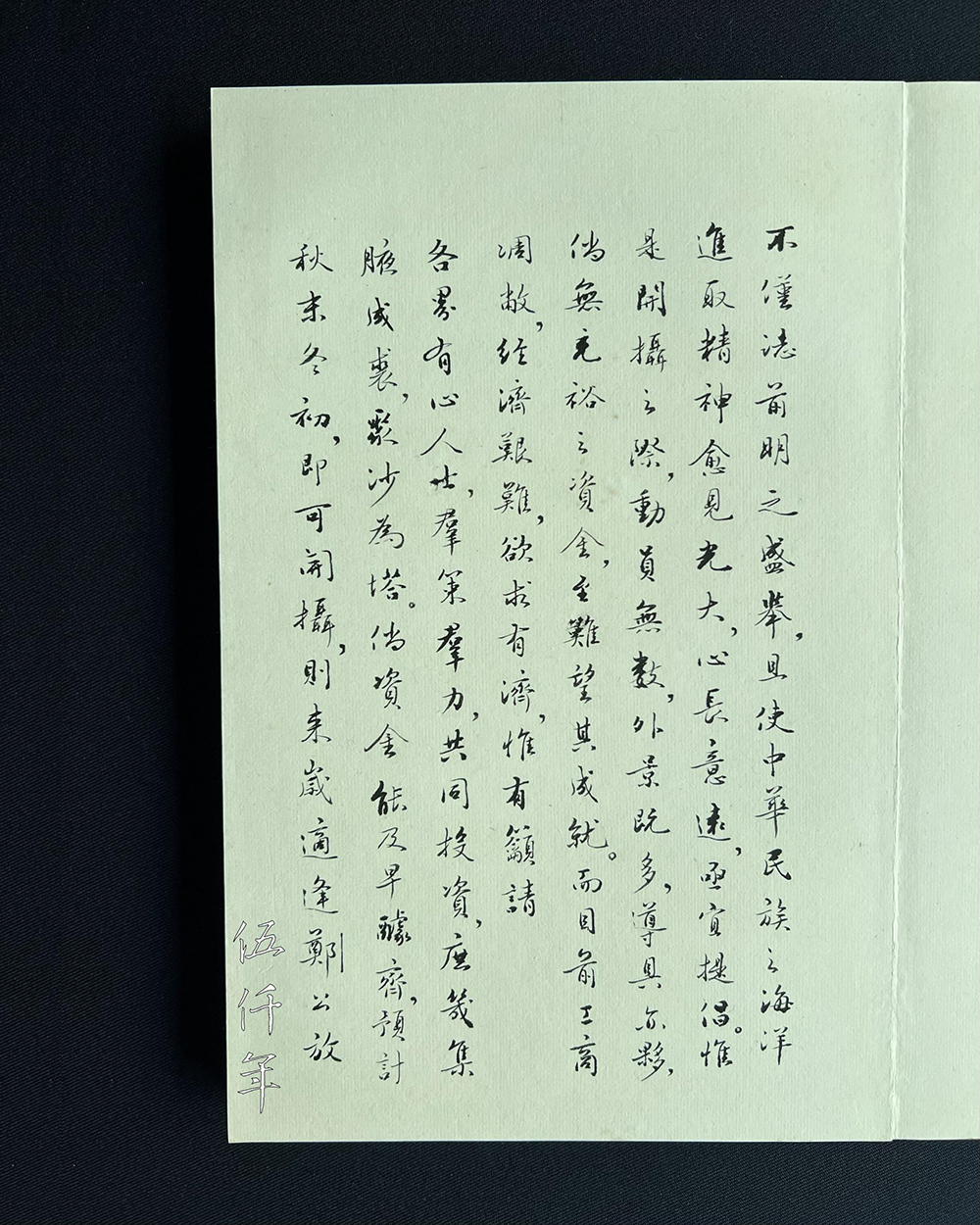
Sixth page of Inception composed and handwritten by my late father Mr. Soong Hsün-leng
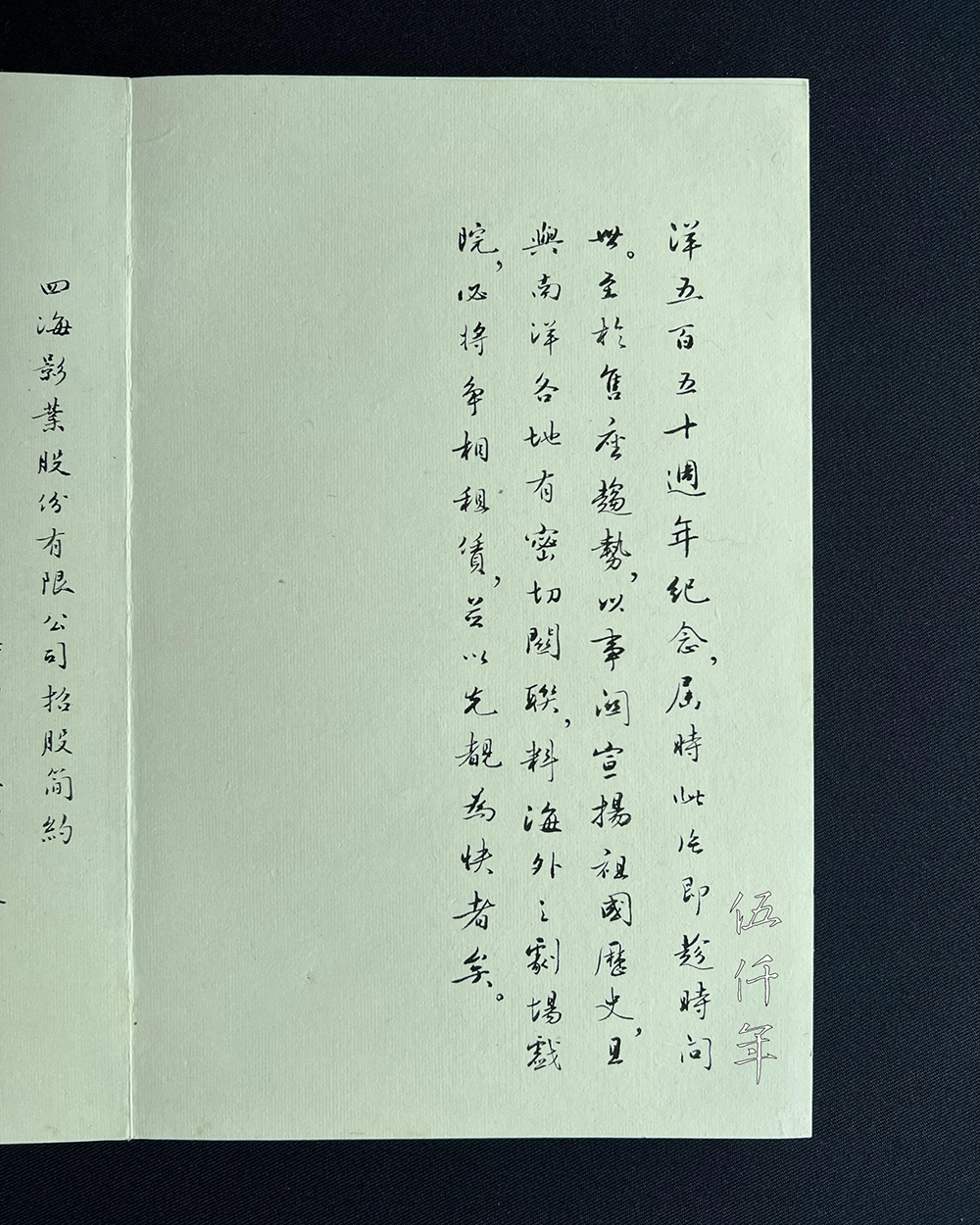
Seventh page of Inception composed and handwritten by my late father Mr. Soong Hsün-leng
As I ponder on the production of this film, it will not only document the grand achievements of the Ming dynasty, but will also promote the indomitable spirit of the Chinese in the context of maritime exploration. It is most meaningful and should be strongly promoted. However, starting the film production process requires massive mobilization of people, multiple outdoor locations, and many film props. Without sufficient funding, it will be difficult to achieve the desired outcome. Moreover, with the present downturn in industry and commerce, with a difficult economy, the only practical way is to appeal to willing individuals from all walks of life. It is only through collective effort and joint investment that perhaps enough resources can be gathered to achieve this goal, like assembling a coat from pieces of fur or building a tower with gathered sand.
If funding arrives promptly, it is expected that film production can start in late autumn or early winter. This timing aligns with the 550th anniversary of Admiral Cheng Ho’s first voyage to the Western Seas, providing an opportune moment for the release of the movie. As for box office returns, considering it’s significance in promoting the history of the motherland and the close connection with various places in the South Seas, it is envisaged that theatres and cinemas overseas will compete eagerly for its screening and audiences will jockey to watch it.”
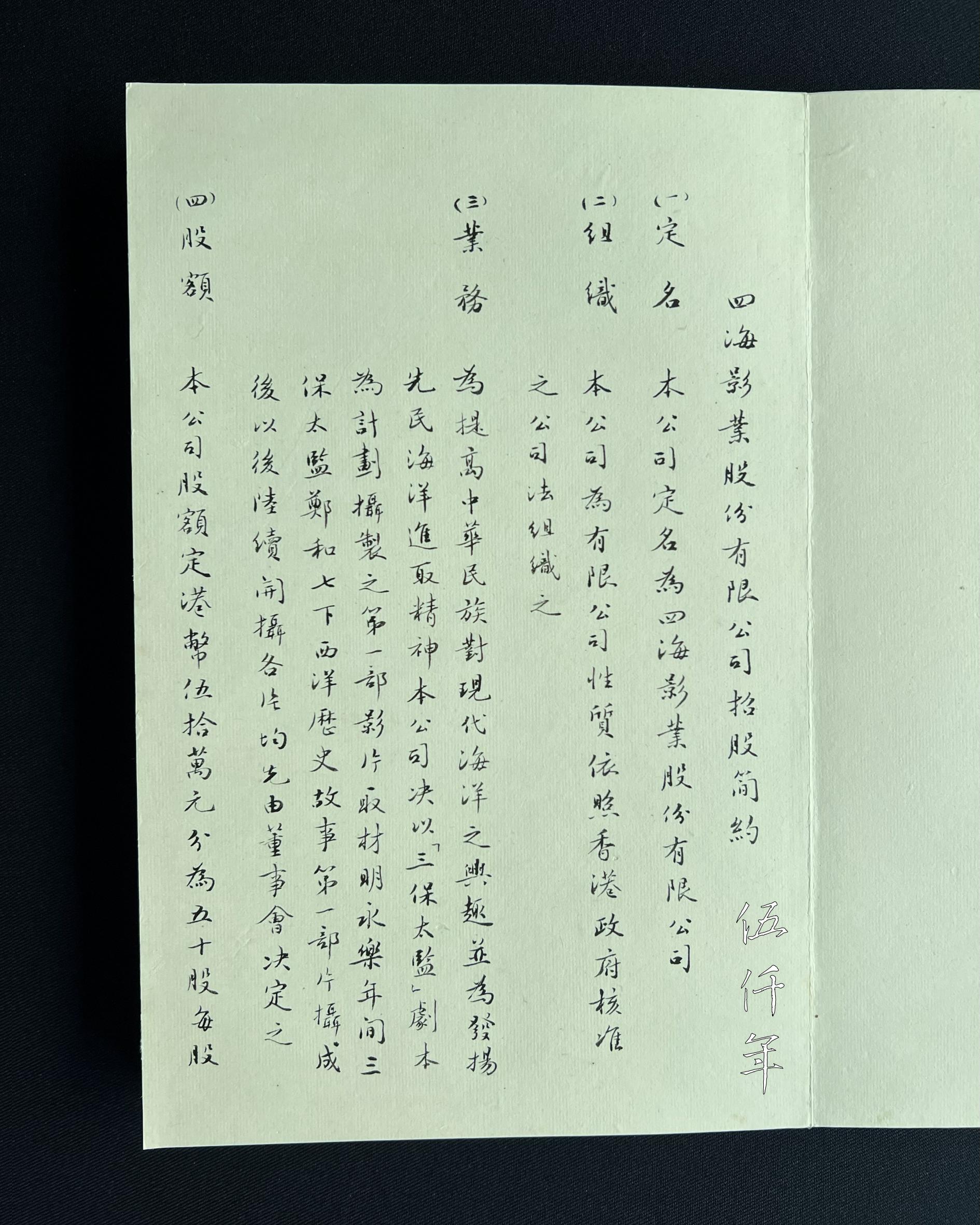
First page of The Simple Prospectus of Four Seas Film Corporation Ltd. composed and handwritten by my late father Mr. Soong Hsün-leng
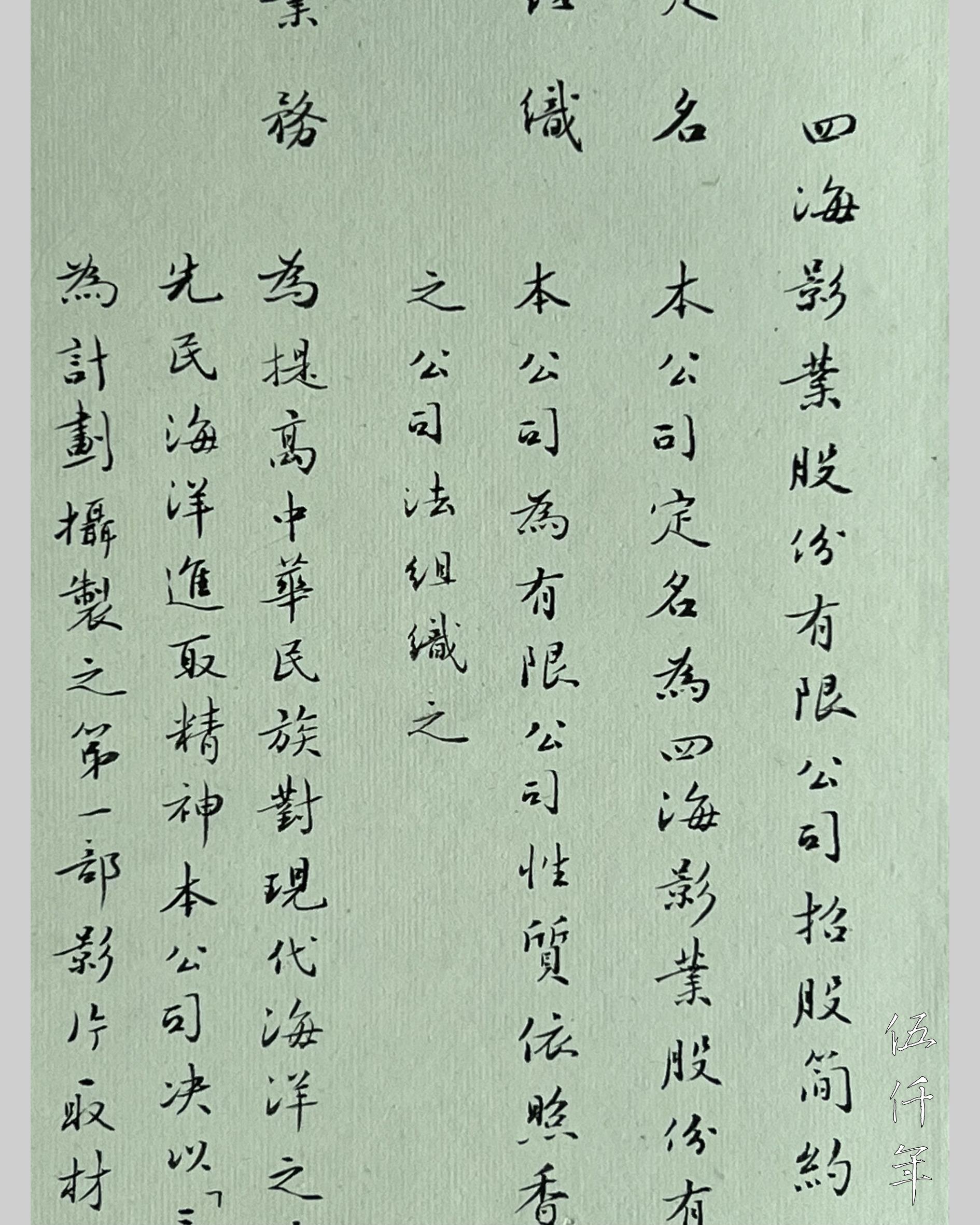
Detail of first page of The Simple Prospectus of Four Seas Film Corporation Ltd. composed and handwritten by my late father Mr. Soong Hsün-leng
This essay is followed by The Simple Prospectus of Four Seas Film Corporation Ltd. It reads:
(1) Company Name: The company is named Four Seas Film Corporation Limited.
(2) Organization: The company is a limited company, organized in accordance with the Companies Ordinance approved by the government of Hong Kong.
(3) Business: With the aim of increasing the interest of Chinese people in modern maritime affairs and to promote the pioneering spirit of our ancestors in maritime exploration, the Company has decided to produce its first film project based on the screenplay “Eunuch San-pao”. The film’s subject is based on the historical story of the Eunuch San-pao Cheng Ho’s seven voyages to the Western Seas during the Yung-le era of the Ming dynasty. Subsequent film productions will be decided by the Board of Directors following the completion of the first film.
(4) Share Capital: The share capital of the Company is HKD 500,000, divided into fifty shares of HKD 10,000 each, payable in full in a single payment. During the subscription period, subscribers shall complete the subscription form and submit it to the preparatory office.
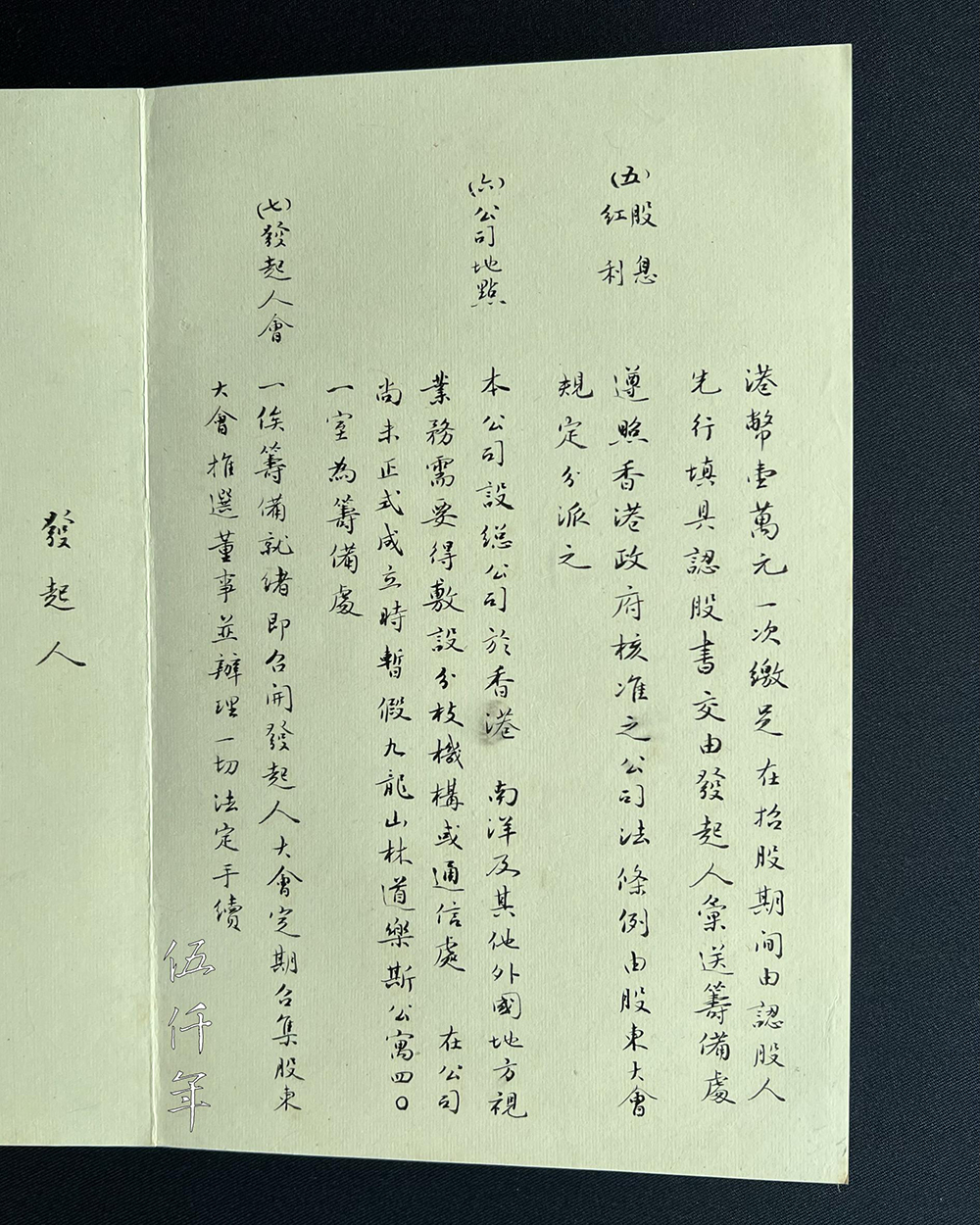
Second page of The Simple Prospectus of Four Seas Film Corporation Ltd. composed and handwritten by my late father Mr. Soong Hsün-leng
(5) Dividends: In accordance with the Companies Ordinance approved by the Hong Kong government, dividends will be distributed as determined by the shareholders' meeting.
(6) Company Location: The company's head office is in Hong Kong. Branch offices or liaison offices may be established in Southeast Asia and other foreign locations according to business needs. Prior to the formal establishment of the company, a preparatory office is set up at Unit 401, Lok See Apartments, Hillwood Road, Kowloon.
(7) Promoters’ Meeting: Once the preparations are complete, the promoters' meeting will be convened. Regular shareholder meetings will be held, directors will be elected and all necessary legal procedures will be handled.
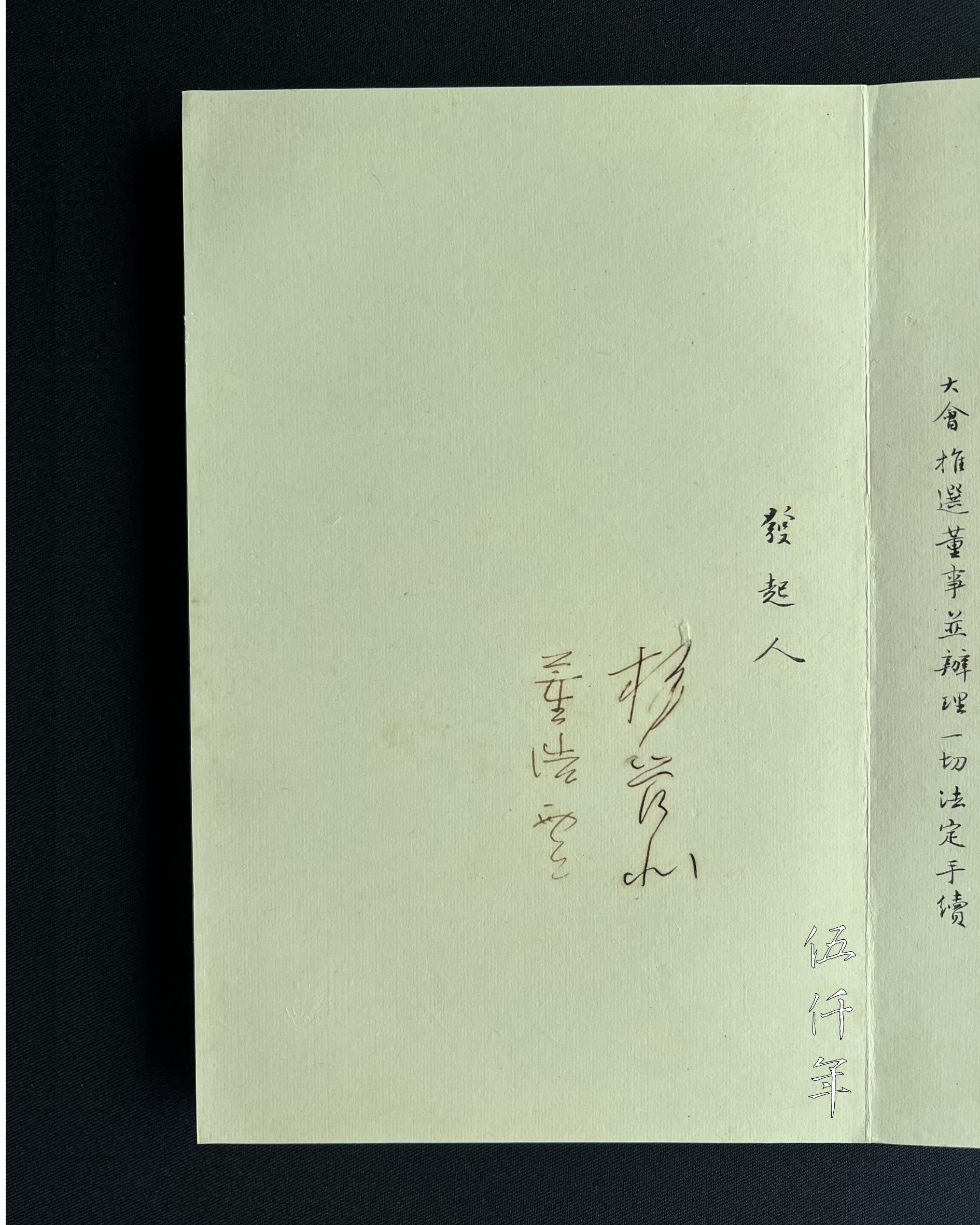
Signatures of Yang Kuan-pei and Uncle C. Y. Tung under the caption of promoter
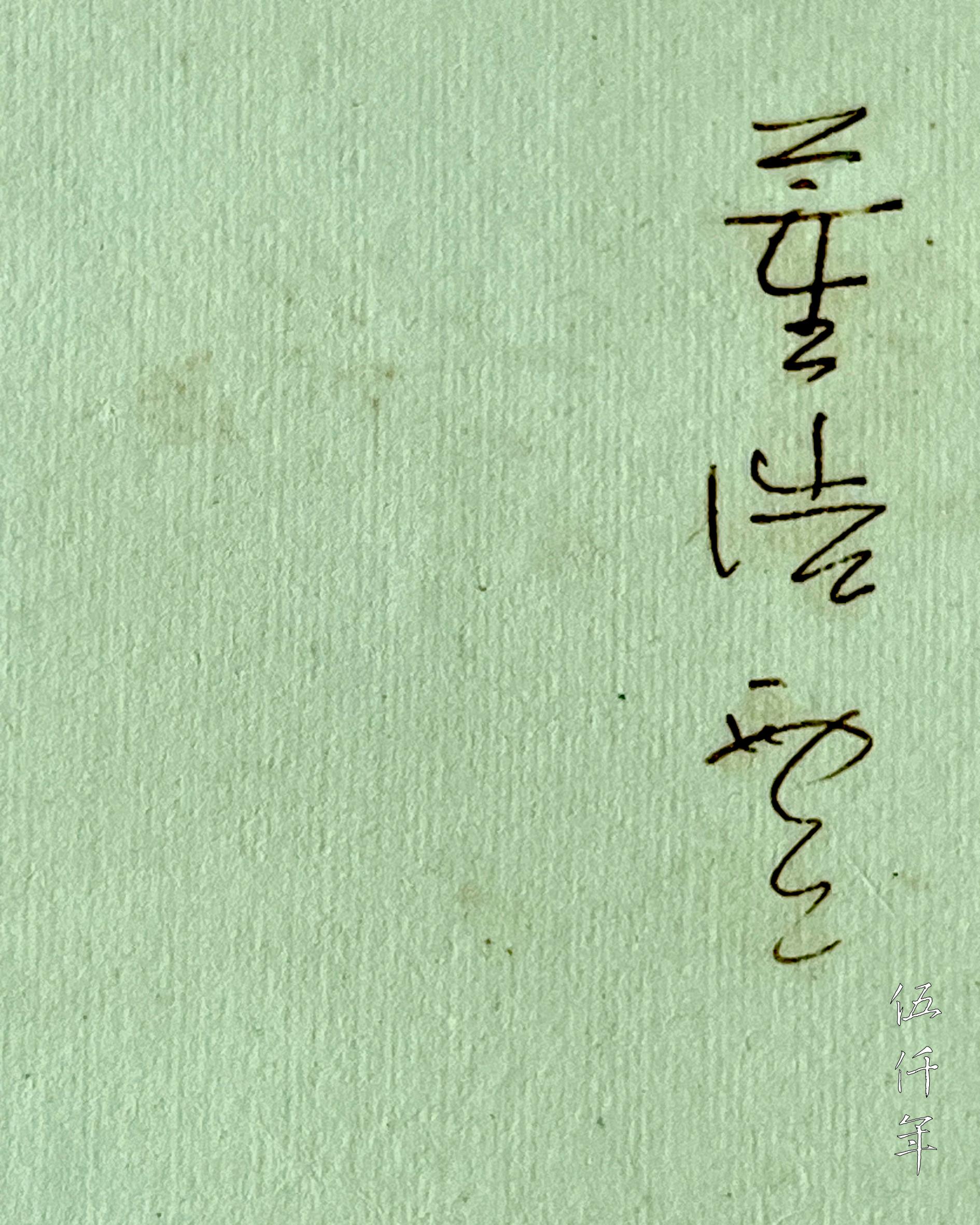
Detail of Uncle C. Y. Tung signature
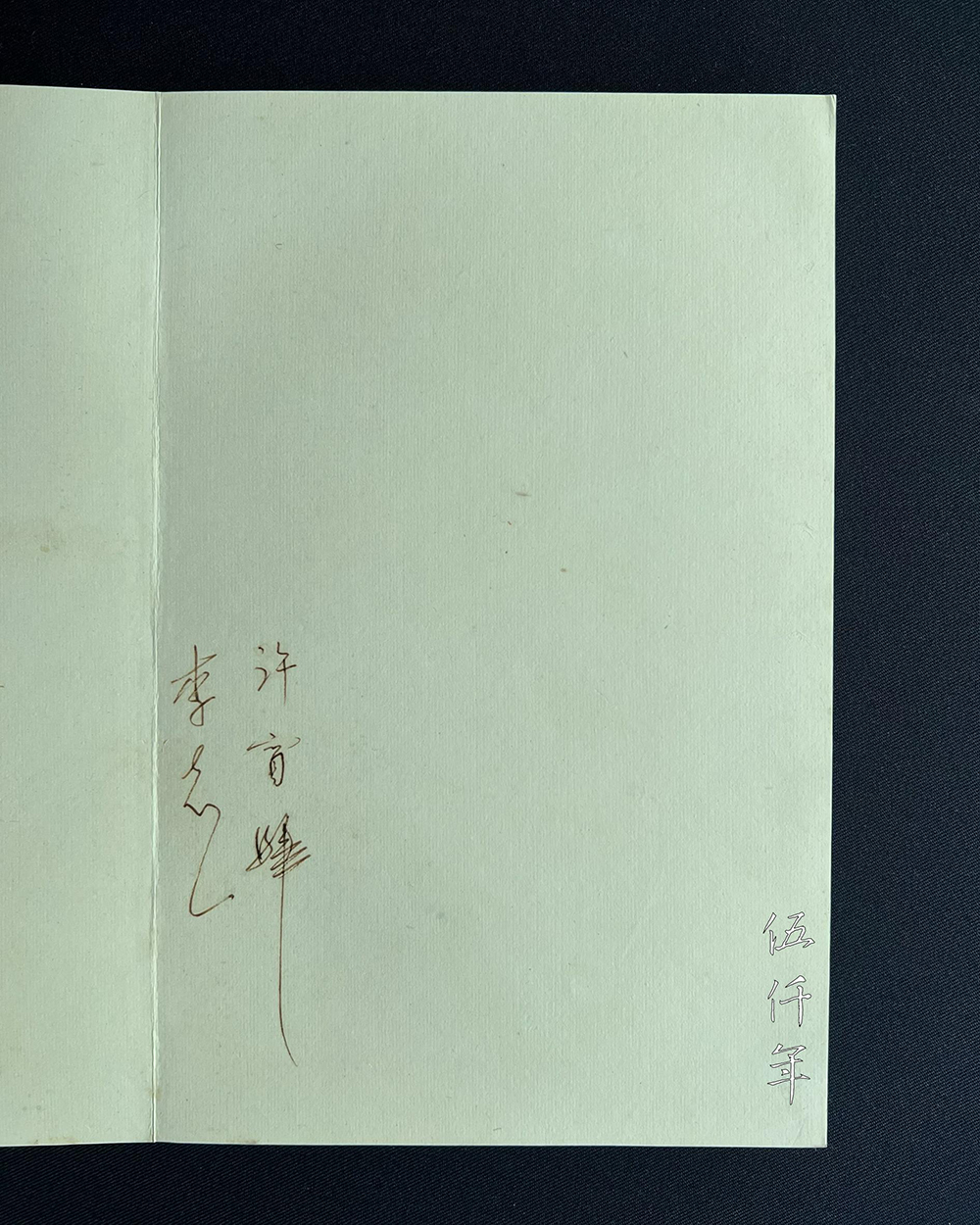
Signatures by Hsu Pao-hua and Li Chih-yi on the second page under the caption of promoter
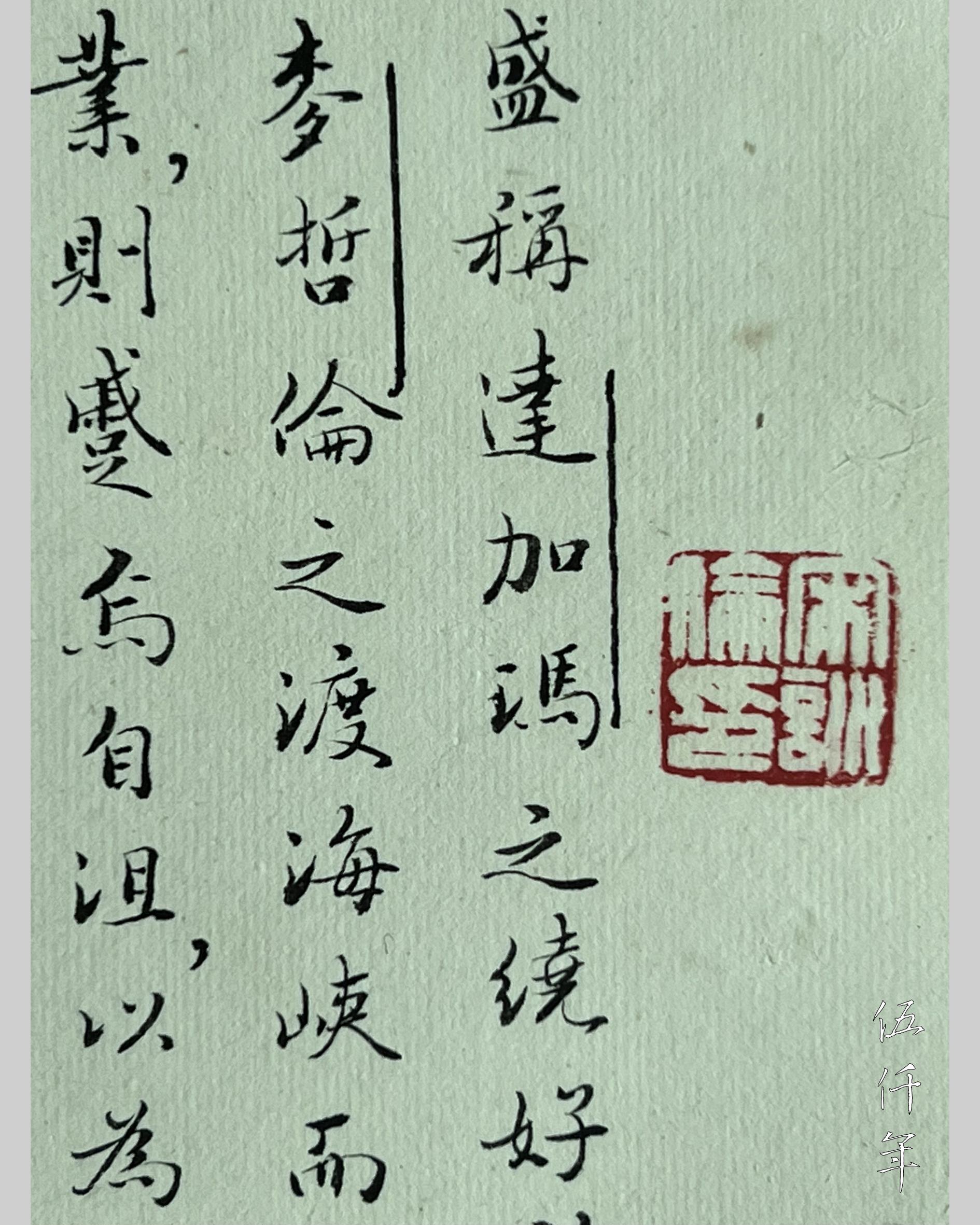
Detail of first page of Inception with the seal impression: “Seal of Soong Hsün-leng”
Promoters: Yang Kuan-pei (楊管北), C.Y. Tung (Tung Hao-yün 董浩雲), Hsu Pao-hua (許寶驊), Li Chih-yi (李志一)
Seal impression on first page of album: “Seal of Soong Hsün-leng”
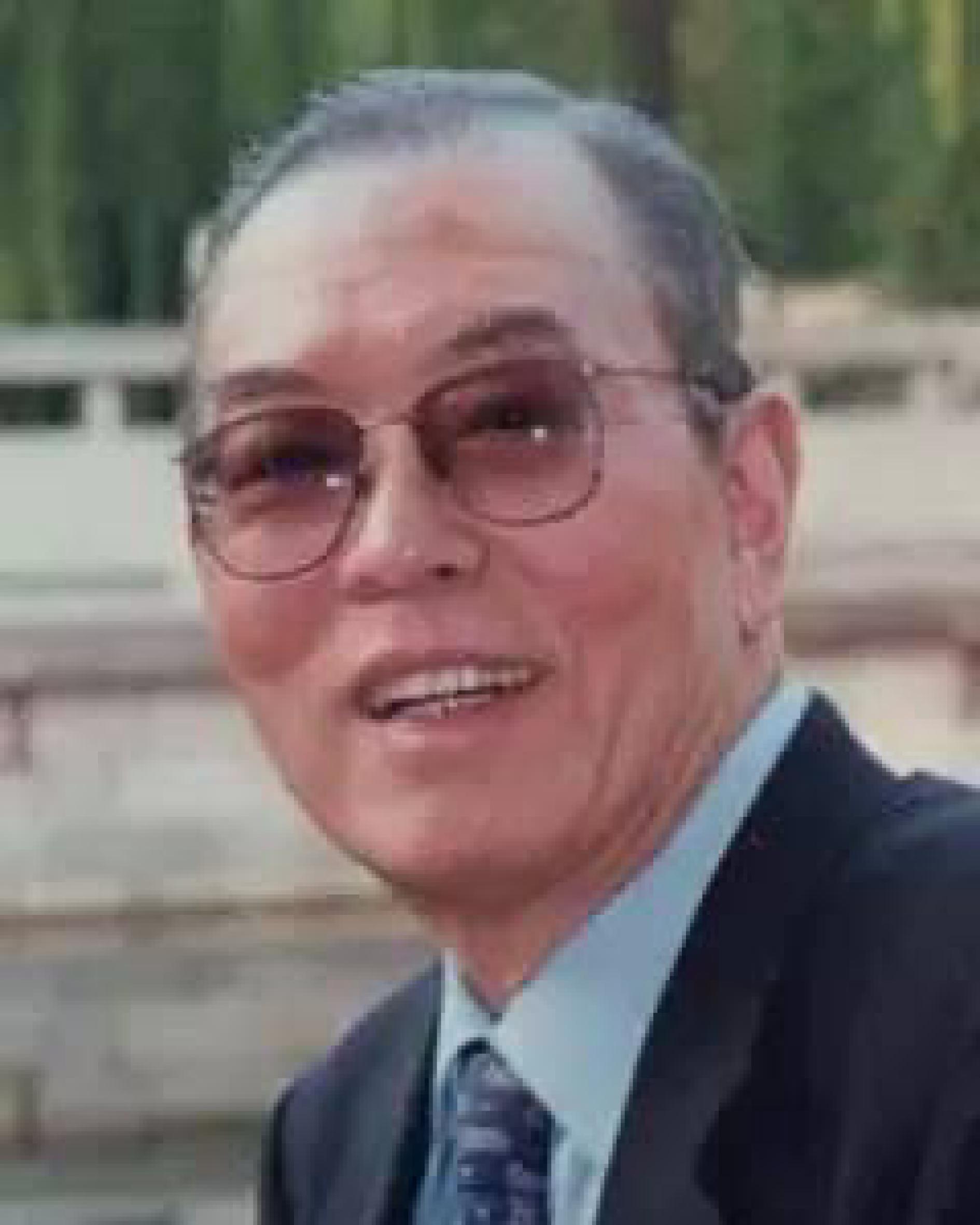
Portrait of Uncle Ku Kuo-min
Uncle C. Y. Tung passed away in the 71st year of the Republic (1982). At that time, there was at least one kindred spirit infatuated with the Movie Scenario of Admiral Chen Ho. His brother-in-law, Uncle Ku Kuo-min (顧國敏) contemplated to follow through Uncle C. Y. Tung’s unfulfilled aspiration to produce this film. In my father’s letter to Uncle Ku Kuo-min dated 5 April in the 79th year of the Republic (1990), there was a rather detailed account of the various aspects of the two screenplays for the Movie Scenario of Admiral Chen Ho. The letter says:
“Upon your second phone call, I personally visited the post office to send this letter on 5 April. I am most surprised that you did not receive it! I have now made two more copies (sent by registered mail), one to the company and one to your residence (with a few minor revisions to the text).
Dear Kuo-min my elder brother:
I have followed your request and sent the following printed materials by airmail:
1) A copy of the essay Inception that relates to the joint stock offering by Hao-yün (C. Y. Tung) and Yang Kuan-p’ei for the filming of the movie on Admiral Cheng Ho. (The essay Inception was written by me. It includes the years, regions, and achievements of Cheng Ho’s voyages. It was composed in the literary form of p’ien-wen (駢文), or rhythmical prose, and seemingly can be recited.) Three years ago, Ch’eng Yu-chai (程餘齋) asked for information on San-pao, I gave him the essay Inception but not the other material.
2) A book published in Taiwan titled A Study of Cheng Ho’s Maritime Routes (鄭和航路考).
3) Huang Yao’s book Chronicles of the Chinese in Singapore and Malaysia (星馬華人) which contains several accounts related to Cheng Ho.
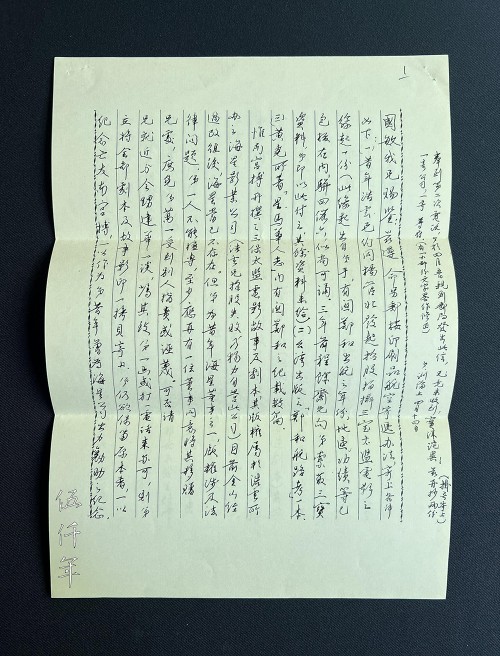
First page of letter by my late father Mr. Soong Hsün-leng addressed to Uncle Ku Kuo-min
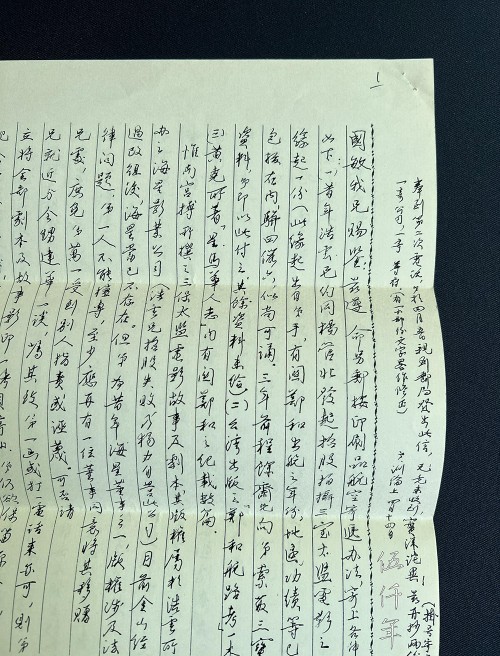
Detail of first page of letter by my late father Mr. Soong Hsün-leng addressed to Uncle Ku Kuo-min
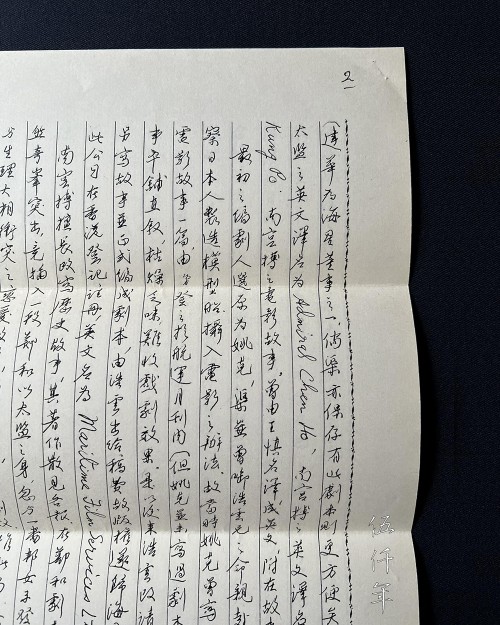
Detail of second page of letter by my late father Mr. Soong Hsün-leng addressed to Uncle Ku Kuo-min
However, the copyright of the movie story and screenplay of Movie Scenario of Admiral Chen Ho written by Nan Kung Po belongs to Hao-yün’s (C. Y. Tung) Maritime Film Services Ltd. (海星影業公司). (Hao-yün managed this company himself after the failed stock offering). Currently, after the restructuring of Island Navigation Group (金山輪船公司), it is likely Maritime Film Services Ltd. has ceased to exist. Since I was one of the past directors of this company, copyright involves legal issues, and I should not make decisions on my own. At the very least, there should be another director who agrees to transfer it to you, to avoid the possibility of me being blamed or slandered by others. Can you please discuss with your nephew Chee-hwa (建華) who is close by? You can ask him to send me a letter or give me a phone call, in which case, I will promptly make a copy of the entire screenplay and storybook to send you.
I still wish to keep the original for two reasons. Firstly, in memory of my deceased friend Nan Kung Po. Secondly, as a momento of my past involvement and assistance to Maritime Film Services Ltd. (Chee-hwa was one of the directors of this company. If he happens to keep a copy of this screenplay, it will then be even more convenient). The English translation of the Chinese name 三保太監 is Admiral Chen Ho. (or Cheng Ho) The English translation of the Chinese name 南宮搏 is Nan Kung Po. The movie story by Nan Kung Po had been previously translated into English by Sherman Wang Shen-ming (王慎名) and is included in the storybook.
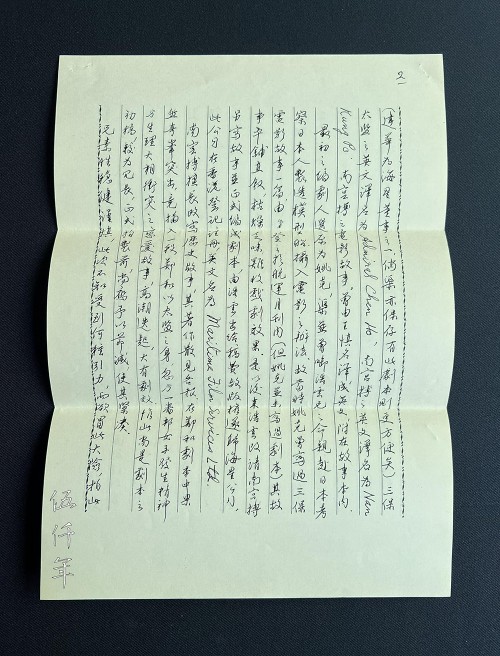
Second page of letter by my late father Mr. Soong Hsün-leng addressed to Uncle Ku Kuo-min
The initial choice for scriptwriter was Yao K’o. He was even sent by Hao-yün (C. Y. Tung) to visit Japan in person to study the Japanese methods of making model ships so that they could be filmed for the movie. At that time, Yao K’o written an article titled Movie Scenario of Admiral Chen Ho which I published in the Maritime Digest bi-monthly magazine (航運半月刊) (However, Yao K’o had did not write any screenplay). His story is straightforward and uninteresting, missing on dramatic effect. Therefore Hao-yün (C. Y. Tung) later engaged Nan Kung Po to write another story, which was formally developed into a screenplay. Hao-yün (C. Y. Tung) paid for the script, thus the copyright belongs to Maritime Film Services Ltd. This company was registered in Hong Kong.
Nan Kung Po was expert in rewriting historical stories, and his works can be found in various newspapers. According to his screenplay for Cheng Ho, he inserted an unusual plot twist where Cheng Ho, as an eunuch, became involved in a passionate love story with a foreign woman, creating intense conflicts both mentally and physically. The story has multiple highlights and a lot of dramatic impact. However this is still the first draft of the screenplay and it is somewhat lengthy. It should be condensed before official production to make it more compact.
Kuo-min my elder brother, you are always steady and cautious. This time I know not what drives you to contemplate taking on such a risky endeavor of making this film with no certainty of success. I am truly astonished!”
Uncle Ku Kuo-min passed away in the 99th year of the Republic, 2010 according to the Gregorian Calendar. It had been exactly twenty years since he received this letter, and no progress whatsoever was made in the filming of this movie.
Uncle Ku Kuo-min (顧國敏 1924-2010) was a native of Ning-po (寧波), Chekiang Province. His father Tsung-jui (宗瑞) was an early pioneer of Chinese shipping. While in Shanghai he worked at Tai Chang Hsiang Steamship Company (泰昌祥輪船公司) founded by his father. In the 38th year of the Republic (1949), when mainland China fell to the communists, he moved to Hong Kong and set up Valles Steamship Company Limited (萬利輪船有限公司). In 1980 he was elected chairman of the Hong Kong Shipowners Association.
Sixty nine years have passed by since my father wrote the essay Inception for the Admiral Cheng Ho movie in the 43rd year of the Republic (1954). The huge investment required and lack of certainty in recovering the capital were the main reasons why Uncle C. Y. Tung did not proceed with the filming of the movie. Today with the rapid advancement in digital special effects, it may be possible to make significant savings on location shootings and large-scale movie sets. Perhaps Cheng Ho, the world's premier navigator, may finally inspire someone to produce a movie to celebrate his remarkable achievements.
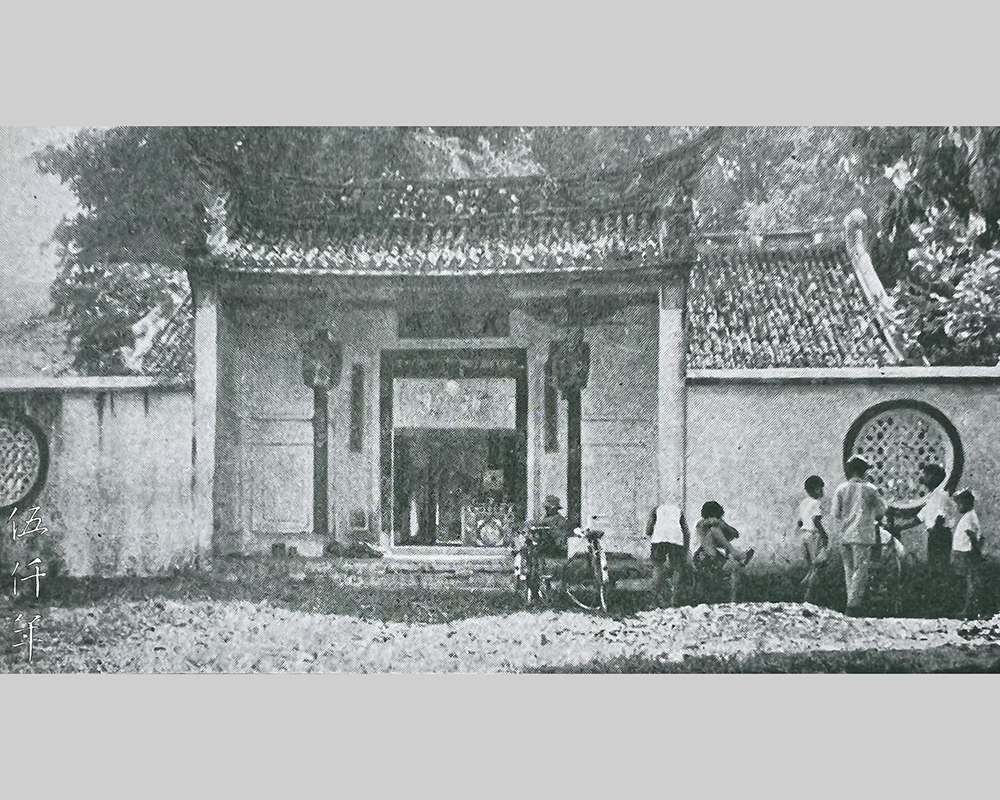
San-pao Palace built by the Chinese in Malacca, Malaysia, to commemorate Cheng Ho. There is a well named after San-pao outside the palace
Related Contents:
Movie Scenario of Admiral Chen Ho (鄭和), by the Late Mr. Yao K'o (姚克)
